Healthy Habits Matter
Greenhill transitions to healthier food choices to improve student nutrition and athletic performance. Page 12


Greenhill transitions to healthier food choices to improve student nutrition and athletic performance. Page 12

similar to a fishbowl discussion, according to Head of Upper School Trevor Worcester.
Important discussions that require vulnerability and honesty can often be awkward for high schoolers, students say.
Now, the Upper School Student Council has launched the Student Deliberation Committee to educate students in effective communication with both peers and administrators.
Last summer, Student Activities Administrator Kira Rivera and three other Greenhill faculty members attended a conference in Washington, D.C. that was focused on deliberation techniques. The conference, hosted by the Close-Up Foundation, taught teachers how to navigate difficult and personal discussions in the classroom.
“The whole point [of deliberations] is to teach students how to have hard conversations, which is super important for things like Student Council,” Rivera said.
Junior Class President Benjy Beckman says he believes deliberations are meant for students to get structured time to share their ideas and express opinions during this process.
“You have a representative from each advisory in a grade level that will be part of the fishbowl, and then you have everybody else that’s the audience,” Worcester said. “There’s stages to it; there’s a whole protocol that [participants] are going to do.”
Although a smaller group will be directly engaging in the discussion, there are opportunities for all students to take part in the process.
“There will be moments where I’ll ask, ‘What does everyone else think about this?’ and people will turn and talk with a partner,” Beckman said. “So, everyone is engaged, but the group of 10 to 15 students is highlighted.”

“It’s a form of conversation to let us propose solutions to problems,” Beckman said. “It’s a great way for everyone to get time to speak and share their ideas.”
The deliberations will be structured
Within these deliberations, there will be facilitators to guide the conversation and pose questions. Last fall, Student Council members from schools around Dallas gathered for another conference, teaching them more about deliberations and how to execute this within the school environment.
“If someone [from the audience] is interested in having the conversation then they can volunteer and be in the middle of the [deliberation] circle,” Rivera said. “The facilitators will be students who attended the conference in the fall.”
At a school with hundreds of students who live in different areas of the Dallas Metroplex, many of them with diverse backgrounds and life experiences,

teaching communication skills is especially important, Rivera says.
“If we only bring you all together in the same room, but we never give [students] a tool to actually understand each other and communicate, then our school is diverse but it’s not inclusive,” Rivera said. “It’s not a place where everyone feels like they can express their opinions.”
Similarly, Beckman says this will be a great way for students of all grades in the Upper School to use their voice to facilitate
discussion and enact change within the community.
“A lot of students don’t feel like we have a good voice on the major problems that really affect us, so I think that this will be a great way to have a conversation about these problems and see everyone’s opinion,” Beckman said. “I think it will enable us to solve more problems with our actual voices and give us more ways to talk to our peers about the problems that affect all of our lives.”
Lyna Kamgang
Four teams from the Upper School DECA club qualified for the state conference on the strength of their Jan. 14 showing at the regional competition.
The club was formed in 2021 by Thomas Rowley ’24. Formerly known as the Distributive Education Clubs of America, it provides students with career development opportunities and a range of businessrelated competitions.
For the first three years, Rowley’s club focused mainly on the Stock Market Game, where students invest virtual money into real-world stocks. But this year marked a significant shift, with eight students competing in five teams in the January
regional conference. Four of those teams will move on to the state conference.
“I’m very happy for everyone who competed,” said sophomore Rahul Singhal, current president of the DECA club. “This is what I’ve really wanted to do since I came to Greenhill. That’s what DECA is really about – going to the conventions and competing.”
DECA offers a wide variety of competitions across business fields, with students engaging in written exams, roleplaying activities and case study events. Some club members compete as individuals while others compete as teams.

Junior Jin Huang, competing solo, and sophomores Nikita Bhasin and Alex Han, as a team, entered the Business Operations Research Event. All three competed in the Sports and Entertainment Marketing category at the regional conference. They had to develop a strategic plan to incorporate artificial intelligence in a local business or organization.
“I was first considering going into music and entertainment, but then I realized I could go bigger by researching the [Dallas Mavericks],” said Huang. “Especially since I had a connection through my friend.”
Huang chose the Dallas Mavericks for her project, while Bhasin and Han worked on creating a plan for the Wize Computing Academy. Each team created a written document presenting their research and prepared an oral presentation to deliver their findings.
“It was eye-opening to tour the Mavs facility with the director of analytics,” said Huang. “I got to see how much AI is already integrated and what I could do to add to it.”
Singhal, along with sophomore Mahedhar Sunkara, participated in the Buying and Merchandising Team DecisionMaking competition. A separate team, consisting of sophomores Tej Sachdeva and Vikram Sampath, also competed in the same competition.
Senior Max Johnson competed in both an exam and an impromptu roleplaying competition.

“We weren’t sure what to expect,” said Singhal. “But we tried to do little things like making business cards and a slogan to stand out to the judges.”
Johnson, competing solo, was asked to explain the importance of savings accounts.
“I was glad that the topic this year was something I knew so much about,” Johnson said. “I really went into the weeds on interest rates and used the full 10 minutes talking to
the judge.”
The Texas State Career Development Conference will take place on March 6-8 in Dallas. After that, if students qualify and wish to advance, they will compete at the 2025 DECA International Career Development Conference on April 26–29.
Looking ahead, many Greenhill DECA students say they are eager to compete.
“I’m excited to go to state because I want to see if I can win,” said Huang.
The club, now that it includes competitions, has seen a jump in numbers, according to older members.
“It’s been cool to see DECA grow,” said Johnson. “In the past two years, we’ve had around 10 to 15 active members. This year, if everybody were allowed to participate, it probably would have been closer to 25 or 30.”
Many of the “career clusters” within DECA are business oriented and include Marketing, Entrepreneurship and Finance.
Singhal says he sees the value of DECA beyond the competition itself.
“DECA is so much more than just business competitions,” Singhal said. “It teaches you how to speak publicly in a limited amount of time and think under pressure. There are so many events tailored to different careers.”
The club’s advisor, Director of Finance Matt Martinson, also participated in the regional competition as a virtual judge.
“It’s a good skill set to have,” Martinson said about the competition. “It teaches you how to talk to stranger, how to interview and all that stuff.”
He has seen how the students’ hard work is paying off.
“They’ve been incredibly selfmotivated,” said Martinson. “As their advisor, I didn’t have to do much outside of facilitating. It’s clear they’re committed to succeeding.”
Evie Kwei
For her work as the chief operating officer and co-owner of the Cook Political Report, and her continued involvement with Greenhill students through the annual eighth-grade trip to Washington, D.C., Kathryn Hamm ’87 has been awarded the 2024-2025 Alumni Service Award.
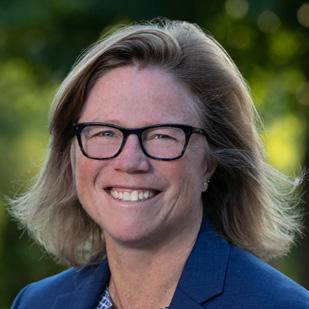
Hamm spent 12 years at Greenhill, beginning in first grade. Throughout her time on campus, she says she was inspired to pursue a career in service.
“I understand that I had far more exposure to a wide range of students than I might have, had I attended a different private school in Dallas,” Hamm wrote in an email. “When I think back on the very best of my experience at Greenhill, I have come to understand that ‘community’ doesn’t happen to you, you have to happen to it. It is something that must be tended.”
She continues her involvement with Greenhill, working with eighth graders each year as they visit the nation’s capital, which she says helps her keep updated with the changes within the school.
“I absolutely love meeting up with the [students] in D.C. every year,” Hamm wrote. “I do my best to encourage them to be themselves, to take advantage of what Greenhill has to offer and to take time to play and not feel so beholden to whatever notion of excellence interferes with their opportunity to love learning and pursuing curiosity.”
John Hurley
AAs the best-selling author of the cookbooks “Indian-ish” and “Priya’s Kitchen Adventures,” Priya Krishna ’09 brings communities together through her culinary storytelling. She was named one of the 2024-2025 Distinguished Alumni for her various achievements.

“It’s really flattering, and it’s very kind of Greenhill to honor my work,” Krishna said. “I feel really thankful for my years there and for the education I got there.”
Krishna says her professional journey started with a love of both writing and food.
“I feel very lucky to have had very good writing teachers [at Greenhill],” Krishna said, singling out Upper School English teacher Trey Colvin. “He taught me the fundamentals, and oftentimes when I’m writing a cookbook, I’m following what he taught me in ninth grade.”
Her most popular cookbook, “Indian-ish,” was inspired by her mom’s recipes. The popularity of the book allowed Krishna to pursue her passion as a restaurant critic in addition to being a food journalist, which she says she never could have imagined.
“When writing ‘Indian-ish,’ all I was doing was documenting my family story and my family recipes,” Krishna said. “People had all these assumptions of what Indian food was and what Indian cooking was, and it was really exciting to write my own narrative of what it really is. It’s the food I grew up with; it’s the food that really feels special to me.”
Art has always fascinated Scott Rothkopf ’95, the Alice Pratt Brown Director of the Whitney Museum of American Art in New York City – and now one of Greenhill’s 2024-2025
Distinguished Alumni for his impact in the art world.

“I’ve loved making and looking at art for as long as I can remember,” Rothkopf wrote in an email. “When I was a child, the Dallas Theater Center was in a Frank Lloyd Wright building, and I became absolutely obsessed with his architecture.”
In the art world, he has curated many notable collections and published various pieces on contemporary art.
“I was lucky to have so many wonderful teachers at Greenhill,” Rothkopf wrote. “[Upper School English teacher] Tom Perryman taught English when I was in sixth grade and he was the first person who made me believe I could write. [My teachers] introduced me to a world of culture and ideas far beyond Texas.”
Roth will be returning to campus for the first time in many years.
“I hear it has changed a lot since my early days there in the ’80s when some of the classes were in portable buildings and old farmhouses,” Rothkopf writes. “If I think back, I can still smell the mildew and carpet cleaner, and hear the whirring of the window AC units, but we all thought it was magical – and it was.”
t the beginning of the 2024-2025 school year, Greenhill instituted a major new policy by ceasing all cash payments across campus.
The shift has changed the way students and their clubs interact with purchases across campus.
From the Buzz to vending machines, students are now reliant on credit and debit cards, mobile payment options and Buzz accounts.
The decision to ditch cash stems from logistical and organizational challenges, according to Upper School Dean of Students George Heinrichs.
“It is just a desire to have better record keeping and a sense of how we are going to manage all of the [oncampus purchases],” said Heinrichs.
Heinrichs adds that cash is much more difficult to handle due to the inconvenience of carrying and counting paper money.
“One issue with cash is that it’s such a bigger hassle,” Heinrichs said. “You have to collect it, you have to count it, you have to note it down, you have to keep it sealed, you have to have a safe. The logistics of that are so much more complicated than when you have a seamless system that is set up.”
Director of Operations and Logistics Crystal Dixon echoed Heinrichs’ sentiment. She said that handling and managing cash required significant extra time and effort, adding work for those responsible for overseeing finances.
“It also improves safety – not that we have a theft issue, but when cash is involved, there’s always that risk,” Dixon said. “Now, students and parents working in concessions don’t have to worry about handling money, and on the back end, we’ve eliminated the need to reconcile everything manually. It’s all automated, straight to the business office.”
student donations have encountered struggles with the new policy. In previous years, these groups would rely on cash payments through bake sales and fundraisers.
Junior Poyraz Roberts, Disaster Relief Club copresident, says the new policy made raising money difficult.
“At the beginning of the year, it was really difficult when you couldn’t take money from everyone and do a bake sale easily,” Roberts said.
Due to the new policy, the students have been
North Texas Food Bank.
He says his fellow class officers have been anticipating lower sales than in years past due to the new cashless policy.
“I hope that there won’t be an impact on how much people participate,” Beckman said. “But it will definitely be a road bump that we have to consider and navigate around.”
Junior Grant Colocousis says he ran into the policy in his first week of school.

“I tried to buy a Vitaminwater from the Buzz,” Colocousis said. “When I tried to give them cash for it, they informed me that they couldn’t take it. I had never heard about it till that point. There was never an email sent out or
With the possibility of a phone ban for the 2025-2026 school year, Greenhill has a system already in place to accommodate for a lack of mobile payment options. Every Upper School student has an account to make purchases at the Buzz and during breakfast in the cafeteria.
Junior Quaid Oza says the system has worked
“I’ve used my Buzz account since middle school, Oza said. “It’s nice to just walk in and grab an item. They already know my Buzz code when I get there so I don’t even have to type it in.”
As Greenhill continues with this cashless policy, Heinrichs says he wants to ensure all students have knowledge of the payment system.
“Maybe a part of orientation is just making every family set [up the system],” Heinrichs said.
Dixon noted the transition was years in the making, with input from Associate Head of School and Chief Financial Officer/Chief Operating Officer Kendra Grace.
“Ms. Grace and I were talking it through probably three years ago when I brought it to her,” said Dixon. “It was always a consideration, but once submitting the formal proposal, it received approval, and we moved forward with the implementation plan.”
Ven Larson, Varun Mukund
The Upper School Science Department recently made the decision to offer AP Physics 1: Algebra-Based as a course option for Upper School students.
This course will first be available in the 2025-2026 school year and will shake up the typical physics trajectory of Greenhill students.
The course, commonly known by the shorter name of AP Physics 1, is directed at freshmen who want to advance in physics and any other Upper School students who would like to take AP Physics 1 as a prerequisite to AP Physics 2: AlgebraBased. The new course offering has sparked discussions among faculty and students.
background for students looking to major in STEM, since standard physics prepared students for other sciences.
“Physics concepts like force, energy and electric charge are foundational to chemistry and biology. Teaching physics first creates a logical progression of knowledge,” Park said.
Similarly, the course will be considered a prerequisite for other advanced physics courses such as AP Physics 2: Algebra-Based, AP Physics C: Mechanics and AP Physics C: Electricty and Magnetism starting in the 2026-2027 school year.
“It provides a stronger background for students who want to pursue advanced physics later,” Park added.
For the 2025-2026 school year, AP Physics 1 is not a prerequisite for AP Physics 2, meaning sophomores, juniors and seniors may take AP Physics 2 without having previously taken AP Physics 1.

The proposal to add an additional physics course was first considered when Upper School physics teachers observed that some freshmen could handle more advanced courses than the introductory Physics course and would benefit from a quicker pace.
Furthermore, freshmen are enrolled in multiple math levels, ranging typically from Algebra 1 to Geometry to Algebra 2. Thus, the Science Department decided to add a new physics course, AP Physics 1.
“The goal was to add an honors physics option, but then we looked at what we would have taught for that specific course, and it turned out to be exactly what AP Physics 1 is,” said Upper School physics teacher Michael Haskins. “So, in our mind, we sort of said, ‘well, if we were going to do this anyway, why don’t we just adopt AP Physics 1 class as an option?’”
Upper School physics teacher Nicholas Park says the addition of AP Physics 1 for freshmen would ideally provide a stronger
OAP Physics 1 was designed by the nonprofit College Board, which curated the content to be equivalent to introductory physics courses at most universities. The College Board designs the curriculum by looking at what is taught in those offerings and compiling that information into an APlevel class.
Rising freshmen are required to take a placement test to ensure that students are prepared for the rigor of the class.
“Well, it's an AP course, it is covering a significantly larger amount of content at a significantly greater level of depth,” Haskins said. “It expects more of you in terms of reasoning and in terms of nuance of understanding and ability to explain.”
While this opportunity is designed to cater to high-achieving students who seek an accelerated course load, some students say they are concerned about the accessibility, suitability and broader implications of such a rigorous class for freshmen.
Freshman Stella Pikar says that adding an AP course for freshmen would add an

unnecessary burden that students would feel obliged to take on.
“There’s so much information crammed in that it’s hard to process,” Pikar said. “Freshmen are already adjusting to high school, and this just adds more pressure.”
Freshman Eli Wenzel worries that introducing an AP physics course will create feelings of inadequacy among students who do not take the class.
“Greenhill already has a cutthroat environment where grades are everything,” Wenzel said. “Adding AP physics will only make students like me feel worse.”
However, other students believe that AP Physics 1 is a necessary addition to the school’s course offerings for freshmen.
Sophomore Rohan Swaminathan says he believes that AP Physics 1 would be beneficial to students as it is a fast-paced and rigorous course that prepares students for other AP courses down the line.
“My sister was taking AP Physics 1 at a different school at the same time that
I was taking Physics 9 in freshman year,” Swaminathan said. “They would cover certain units in about three days – units which sometimes took us three weeks.”
Swaminathan is currently enrolled in AP Physics 2 and says that the jump from the entry-level freshman physics class he took last year to AP Physics 2 was challenging.
“I think it probably would’ve been helpful to have AP Physics 1 in freshman year,” Swaminathan said. “I would have definitely taken it because it would have prepared me for the intensity of AP Physics 2.”
While some students have concerns regarding the implementation of the course, Haskins says he believes this change will give students who are aspiring to pursue physics in the future a steppingstone to achieve that goal.
“It provides an opportunity for students in every grade level who would benefit from [taking] that course,” Haskins said.
ver the past several months, Greenhill senior Michelle Akins has worked with a team of Upper School Design and Innovation students to create a new college counseling website for public schools that incorporates the use of artificial intelligence.
The name of the website is Edaiya, and the aim is to provide a smooth and equitable college admissions experience, according to Akins.
Akins first got the idea for the project when talking to public school friends. Her friends described an overwhelmed system in which their college counselor-to-student ratio was roughly four counselors to 500 students, compared to the Greenhill ratio of about one counselor to 30 students.
Her idea was to develop a website that would put more information in the hands of students involved in the college application process.
“We’re here to help the college counselors manage all these students, and to help the students with college applications and giving them the right resources,” said Akins.
Akins’ vision is to use artificial intelligence to create a video and messenger chatbot on the site that can answer student questions or take notes during a phone conversation that the student can look over later.
There is also a message space, like ChatGPT, where students can text the AI bot
any questions they have about the process.
In a public-school setting, students have to set up meetings with a counselor, and that can be a lengthy process, Akins said. She says that her website will make getting answers to questions about college easier for these students.
architecture and lay out of the app with usercentered design techniques, according to UX Design teacher Luna Kim.
“I take the base designs that have all of the information [Akins] wants on the page, and I help design them to make them look more modern,” said Qureshi.
and shooting a 30-second commercial for Edaiya, according to freshman Ayaana Joshi, one of the project interns.
"The goal of the video is essentially, in less than 30 seconds, to let people know what Edaiya is about,” said Akins.

"In a school where there are thousands of kids per grade, you can’t really have a meeting with a college consultant because they’re so busy, so I think [Edaiya] is really going to help with quick questions or inquiries that students have, giving them a really personalized process,” said Akins.
A huge privilege of going to private school is being able to have college counseling meetings whenever, which isn’t the case in public schools, Akins says.
“The main goal of the website is to bridge the gap between public school and private school college counseling, so that everyone has access to the same resources and has the same advantages,” said Akins.
When she started developing her web application, Akins says that she collaborated with the Upper School Honors and Advanced Computer Science classes and Honors UX Design class.
The students from the Honors UX Design class, led by sophomore Noora Qureshi, helped Akins design the
While the UX Design class designed the aesthetics of the website, those in the Computer Science classes began developing the functionality of the app, according to Kim.
Akins also recruited interns through a poll sent to the entire school.
The 10 interns work in four main teams: fonts and logos, web design, data and research and commercial and film.
The fonts and logos team focuses on developing a brand for the company, including finalizing the color palette of the website and creating a memorable logo, according to Qureshi. The web design team ensures the users of the website have a smooth navigational experience.
"The [web designers] help to make the website more accessible to the users so that they can have an easy and fun process,” said Akins.
These two teams work to create a visually welcoming website that makes users eager to start the college process, says Akins.
"We want them to feel like this [website] is their home and planning their future is an exciting thing,” said Akins.
The data and research team is examining Edaiya’s competitors, like other college counseling websites, and is researching the college counseling systems in public schools.
The film and commercial group is working on the marketing aspect of the website. They are currently writing, directing
The students from the coding and design classes are currently developing and coding the main Edaiya web pages, in preparation for Greenhill’s annual What’s NEXT Pitch event in April, Akins said.
“We’re currently developing our pitch and we’re doing a ton of financial modeling, which is essentially projecting how much money we’re going to make in the future, and what our costs are going to be,” said Akins.
Akins plans to launch the website in 2026 to private subscribers, like parents and individual students, before launching again in 2027 to large public school districts.
“Hopefully, [Edaiya] will get to the entire world and inspire a lot of people to look to their future and know that something bright is ahead,” said Akins.
Students affiliated with the Edaiya project hope their business journey and its challenges will inspire the Greenhill community, says freshman Gitanjali Agastya, another intern.
For Akins, it’s thrilling to see an idea that began with some scribbles on a piece of paper evolve into such a promising business startup.
“Seeing [my interns] so passionate and enthusiastic about this makes me so happy,” said Akins.
Noa Pouratian, Nithya Rao
Seven Middle School swimmers earned 1st-place honors Feb. 1 in the Season Finisher Meet in Fort Worth.
The Middle School girls finished 1st overall in the meet while the boys finished in 2nd place.
The swimmers winning their races were eighth graders Naila Amol, Maahi Varma, Carrie Wang, Austin Yao and Andrew Zheng and seventh graders Hailey Marshall and Sophie Trombley.
Overall, team members posted 33 personal bests.
“The coaches are so proud of each and every one of [the swimmers] on the team,” said Head Coach Gabi Grobler in an email to the team. “You have all made an impact on this program.”
Prior to the meet, Grobler was hopeful about the team’s chances.
“I think we’ve had a great season to
prepare,” said Grobler. “I think we’re going to be pretty dominant.”
In the days before the meet, Assistant Coach Melanie Girard said she was looking forward to seeing the swimmers try their best to improve.
“Every year the kids really surprise themselves,” Girard said.
The coaches are so proud of each and every one of [the swimmers] on the team. You have all made an impact on this program.”
Middle School swimmers prepared for the meet by practicing tapering, which is reducing the yardage that they swim so they can focus on quality, hard sprints and test sets. In test sets, swimmers go through different strokes and record the times to see which are best suited for each race.

Encouraging teammates is important to success in a meet, according to eighth grader Ansh Verma. The team practiced camaraderie at the meet by having a buddy system where each swimmer made a sign for a teammate and cheered them on.
Yao said that a positive and supportive team culture is very important for the team as a whole because of the way that meets are scored. Each individual event is worth 7-20 points while the relays are double the amount.
“You need to encourage people because swimming is a team sport,” said Yao. “You’re actually gaining points for your team in cheering for them to help them swim better.”
Yao added that the implementation of the buddy system helped the team develop a stronger bond.
Swimmers such as Verma expressed how this system encouraged them to connect with new people on their team and create a bond.
Pre-race nerves are common, according to some swimmers, but the feelings among team members were varied heading into the Season Finisher Meet
“I was not nervous, I felt prepared,” said seventh grader Vivianne Wang.
You need to encourage people because swimming is a team sport. You’re actually gaining points for your team in cheering for them to help them swim better.”
Many of the swimmers on the team described how the coaches prepared them well by constantly encouraging the team with motivational speeches.
“We give a lot of pep talks,” said Girard. “We want them to feel excited.”

The Middle School has introduced a new competition called Latin League, which is different from the traditional Latin competition, National Junior Classical League or JCL.
Unlike JCL, Latin League doesn’t require travel, making it perfect for students who want to participate but have other weekend commitments, according to Middle School Department Chair for Modern and Classical Languages Joan Romanosky, who also teaches Latin in grades 5-7.
“I thought [Latin League] would be a great idea, so I gave students the opportunity to try it out,” said Romanosky. “I wanted to see who would be interested. We ended up with four full teams, which is the maximum.”
Latin League is a yearlong competition between schools all over the country. This is the first year that Greenhill has participated, sending both Middle and Upper school teams. In Middle School, there are two junior varsity teams for sixth and seventh graders and two eighth grade varsity teams. Approximately 20 students compete in the Middle School division from Greenhill, according to Romanosky.
Students have been preparing for their competitions since October by using a study guide to review 100 questions about Roman history and Latin writing and reading comprehension. Romanosky says the test also includes special topics like famous women in the ancient world and medical
words that have Latin and Greek roots.
“We assign ourselves stuff to study, [and] Magistra Romanosky has been very helpful because she tells us what will be in the next competition, so [we] know what to study for,” said sixth grader Aarna Gandhi.
So far, students say they are enjoying the Latin League.
“It’s very fun,” said sixth grader Arjun Shah. “I totally recommend it especially because it goes all the way through the year, and we’ve been doing it since October.”
Sixth grader Vikram Thoduguli also says he is enjoying the Latin League experience.
“It’s really fun to see how everyone brings their own part to the team,” Thoduguli said.
I thought [Latin League] would be a great idea, so I gave students the opportunity to try it out. I wanted to see who would be interested. We ended up with four full teams, which is the maximum.”
Since the Latin League is a team effort and often allows collaboration between peers, sixth grader Arjun Shan says she especially enjoys working with other students.
“It’s super fun. I totally recommend it,” said Shan. “I really enjoy the team aspect. It’s fun, interesting and a little complicated.”

All his life, no matter the activity, senior Andrew Cai says that he has struggled to receive and implement feedback in his work.
Nowhere has this battle been more prevalent than when he chose to pursue kendo, a modern Japanese martial art.
Every time he went to practice, Cai had to spar opponents of all ages and levels. He says he soon realized that to improve he would have to learn from his peers and merge their advice into his own game.
“For a while, whenever someone gave me constructive feedback, I tended to overthink it and believed that they were trying to be condescending,”
Cai said. “But kendo has really taught me to take feedback as is and just learn from it to improve yourself.”
Kendo is only one of Cai’s many activities, as he enjoys marketing, making films, playing the piano, swimming and helping run a community service program.
All of these extracurriculars, along with the people involved in them, helped shape Cai into not only a good student but also an overall better person, according to Upper and Middle School Video Production Director Corbin Doyle.
senior year, Cai and Agha have decided to take on the ambitious project of creating an anthology, which is a series of short films that all connect through a frame story.
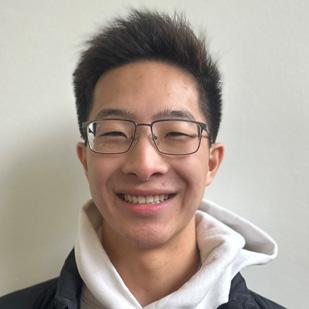
One thing that Cai, Agha and their
filming anything interesting. Cai began editing the videos into short-form content for various social media platforms.
“We’ve seen that work translated to some of our big events, like the charity concert last year that had thousands of people show up, including the mayor,” said Xie. “He regularly films our events and advertisements. He’s always been

Cai notes that Doyle is one of the people who has driven his improvement.
“Mr. Doyle is a big inspiration because without him, I wouldn’t have enjoyed video production as much as I did,” Cai said. “He gives me the encouragement to keep going and to excel with every project, no matter what that is.”
Following his parents’ suggestion, Cai joined the Video Production class his freshman year with no more ambition than completing a mandatory art credit. But he soon developed a love for filmmaking.
“As a teacher, there’re just some students that are more attached to the process than others,” said Doyle. “Andrew is one of those dudes who is always connected to the process.”
To make the best films possible during his freshman year, Cai needed to team up with another film student.
He found this help through current senior Ali Agha, and their four-year partnership was created. From then on, Cai and Agha co-directed all their films together, relying on each other throughout the process.
“He’s the only reason any of my ideas will end up in film,” Agha said.
For the end of their
“I want to end senior year with a really good film, kind of like a capstone for my three years in Advanced Video Production,” said Cai.
management, receiving feedback and being more accepting, specifically through kendo.
“My kendo dojo is very diverse and there are people of all ages and levels, so you are bound to run into opposite political views or any other disagreement,” said Cai. “Because of that you have to learn to hear other perspectives and be more open to different opinions, which I think is something everybody could work on.”
Cai recently got accepted to Emory University in Atlanta, where he plans to study marketing. He says he wants to minor in economics or data science.
“The reason why Emory was my number one choice is because it has different concentrations within business majors that you could do, called area depths,” said Cai. “The area depth I’m doing is Film and Media Management so there’ll be classes about film and how business connects to that.”

Xie says he is certain that Cai will be successful.
“He’s learned under some very experienced adult mentors who have taught him a lot about marketing,” said Xie. “I think all of his prior experience will definitely help him out in college.”
Cai has already decided some of the clubs and extracurriculars he would like to join.
“[Emory] has an AVP adjacent club called ETV and I will be joining that,” said Cai. “Atlanta has multiple kendo dojos. I already talked to my sensei and he said he would connect me with some, since he travels a lot.”
Using his experience in filmmaking, Cai found an off-campus use for his talent through the NiHao Food Bank Initiative. This volunteer-driven organization is run by Chinese Americans and has the goal of raising awareness about hunger in North Texas.

After learning about the organization from current senior Harris Xie, Cai joined the organization as a volunteer.
After a few years, Cai says he realized that he could help more people if he applied for an official position in the organization rather than just coming to help from time to time. Cai took a position in the marketing department and later applied to be the executive vice president of
He got this position last summer and drew on his film skills by attending events and
Being involved in a plethora of extracurricular activities causes Cai to have a grueling schedule.
On weekdays, Cai says he wakes up at 7 a.m. to get ready for school. After his school day, he heads to swim practice or, on Fridays, kendo practice from 6:30 p.m.8:30 p.m. Immediately after working out, he heads home to shower and eat dinner before starting on his homework. Cai works on his assignments until around 11 p.m. and then goes to bed.

On Saturdays, Cai practices kendo from 3:30 p.m.-5:30 p.m. and on Sunday mornings he takes piano lessons for an hour.
“The biggest challenge with my demanding schedule is time management,” said Cai. “Recently I’ve been finding myself using my phone for too long. When I’ve been on it for over an hour, I try and hide my phone, whether that’s in my pocket or behind a stack of books. If it’s just out of sight, it’s out of mind.”
Cai has learned many lessons like time
When college classes start and his workload increases, Cai anticipates having to make some sacrifices.
“I would most likely be dropping piano lessons,” Cai said. “But Emory has practice rooms, and I have a repertoire of pieces memorized, so I will still be playing those in my free time.”
Once fully settled in Atlanta, Cai hopes to find employment.
“I’m hoping to get a job that utilizes being creative while also using the quantitative skills that marketing has to bring.”
Atlanta has a lot of media-intensive companies like CNN and Coca-Cola, a major Emory donor, and some of them would require a marketing degree. Cai says that all of these future opportunities are exciting as he wants to continue his passion in film.
“In the next 10 years, I hope to graduate and get a job where I can use quantitative skills, while also continuing to use the creative skills Greenhill and AVP gave me,” Cai said in a text message. “I also hope to be working in Hollywood in the marketing sector, or as a director, so I can continue my passions and also expand my skillset.”
Chloe Nguyen, Ella Sadka
From improving their health to changing their mindset, Hornets welcomed the New Year with resolutions aimed at growth and improvement. Below is a sample of what Upper School students hope to accomplish in 2025.

“To go to bed earlier. Especially with my surgery and baseball, I want to [get] more rest for
– junior Andrew Hough
“To think of three positive things that happened and what I’m grateful for at the end of each day. This way, I can end the day off on a positive note.”
– senior Camila Hanson
“To surround myself with people I love and that will help push me to be the best version of myself.”
–sophomore Brielle Kommer
“To drink more water. It’s really important to stay hydrated.”

– junior Sophie Carruthers

“To eat less processed sugar, like in sodas and sweet treats. I want to be healthier this year.”
– senior Hayden Sampson
“To be a better person, as a friend, student, daughter, etc. I plan to start this by dedicating more time to the people I care about.”
– senior Saida Bidiwala
Aria Kutty, Evie Kwei
Some students on campus struggle to pinpoint the responsibilities and day-to-day routine of Head of School Lee Hark. Although his current position is more removed from the classroom, he started his teaching career at his high school alma mater.
“I got a call from the head of school at my old school [in Rome, Ga.], Darlington, and he asked if I wanted to come down and interview for what was essentially a fellow’s position,” Hark said. “I interviewed, and I just loved being back on campus. I took the job, and that was 30-something years ago.”
Following his time as a teacher at Darlington School, he continued his career at Providence Day School and Durham Academy in North Carolina, where he served as the assistant head of Upper School and dean of students, and the Upper School director and associate head of school, respectively.
Eventually, he decided to move to Texas after hearing about Greenhill from former Head of Upper School Ed Costello.
“The head of [Durham Academy] at the time, Ed Costello, had actually worked here at Greenhill,” said Hark. “He kept telling me, ‘You really ought to think
about Greenhill. It’s a wonderful school,’ and so when [former Head of School Scott] Griggs was in the process of leaving, I came out and interviewed and fell in love with it.”
Seven years later, Hark has made his mark on Greenhill. Although he has engaged in a number of projects across campus, he focuses his involvement in key areas.
“I would say that there are a couple of things where the head of school plays a vital role. One is communicating to the community what’s important, like school values, and defining and explaining critical issues for our community,” said Hark. “The other thing is connecting people in the school, and I think the head’s office is a point of connection in a lot of ways.”

Beyond the communications aspects of the job, the head of school also addresses operational concerns.
“Fundraising, employment and solving problems are a big function of this office,” Hark said. “I try to make people’s experience as good as it can be, but the head
does have to tell people ‘no’ a lot. I end up being the final decider for a lot of really thorny problems.”
Hark focuses on defining the community at Greenhill and presenting the school as a cohesive institution. He says it’s important for the school’s values and mission to stay current and properly represent the diverse student body.
“What makes Greenhill great? It’s the community,” Hark said. “There are a lot of great schools out there, but there are very few who are committed to the things we’re committed to, who do the things that we do, and who attract the people we attract.”
Despite the difficult situations and complicated issues, Hark still feels lucky each and every day when he drives on campus and gets to serve the Greenhill community.
“There are so many hard parts about being head of school, but [Costello] said to me, ‘Never forget that you have the best job in the school.’ And he’s right. It’s the best job,” said Hark. “I have the privilege of having a perspective on the school that no one else gets to have. I find this community so inspiring and energizing, and it’s just so much fun.”
When Associate Head of School for Mission, Community and Culture Tom Perryman ’81 was finishing up his bachelor’s degree in English, he had no idea that his career would start at his alma mater, Greenhill. And even more unpredictably, he had no idea that he would still be on campus more than 40 years later, serving as an associate head of school.
“I had no idea what I wanted to do, [and] I wasn’t spending a whole lot of time thinking about what I wanted to do,” Perryman said. “Actually, I wanted to be quarterback of the Dallas Cowboys, but that was not going to happen.”
Eventually, during his senior year in college, he got a call from then-Head of School Phillip Foote.

“[Foote] had sort of been a mentor of mine when I was a student at Greenhill, and he called me up and said, ‘What are you doing next year?’ and I said I didn’t know. I was just trying to graduate from college,” Perryman said. “I came out here and met with him, and he said, ‘I think you’re a teacher.’”
Perryman, a former Sunday school teacher at his church and camp counselor, had many childhood relatives who were teachers. All of this, combined with Perryman’s own time at Greenhill, convinced him to take Foote up on his advice.
Associate Head of School and Chief Financial Officer/Chief Operating Officer Kendra Grace plays a pivotal role in Greenhill School’s operations, overseeing everything from finances to facilities to ensure the institution runs smoothly.
In her roles as chief financial officer and chief operating officer, Grace’s broad responsibilities include human resources, security, logistics, summer programs and even the dining hall, with 12 direct-report employees overseeing these operations.
“If it’s behind the scenes and keeping the school running, it probably is happening in [my] office,” Grace said.
After being drawn to the school’s mission, Grace joined Greenhill as director of finance. Just two months later, after the longtime chief financial officer announced her departure, Grace decided to apply for the position.
“I had been really impressed with the school and
“I thought that [teaching] would be cool,” Perryman said. “I love Greenhill a lot. I had an amazing experience as a kid, so I really value this place.”
Returning to campus as a faculty member, Perryman started off as a sixth-grade teacher. After five years of teaching, Foote approached him again with an offer to become the head of Lower School, his first foray into the administrative world.
However, since teaching really brings him joy, Perryman only agreed to take on the administrative role if he could continue to teach.
“My last negotiating chip [with him] was that ‘I’ll do it if you will always let me teach an Upper School English class,’ because [Foote] was the one who first spotted that I’m a teacher,” said Perryman. “Administration is dealing primarily with adults, and that’s not what brings me joy. [Being in] class, it’s the 80 minutes of the day that I most look forward to.”
In addition to teaching an Upper School English class each semester, Perryman oversees the Heart of the Hill program and the Carter Associate Teacher Program. He also travels across the country to visit alumni and works on various projects.
“A lot of my job is based on relationships, and just knowing this place,” Perryman said.
Currently, he is working on Greenhill’s 75th anniversary project, and he has interviewed early alumni of color to document this part of the school’s history. This
what it stood for, so I applied,” she said. “Really quickly I just fell in love with it.”
Grace’s upbringing influenced her career path. Her mother worked at her school as a biology teacher, track coach and college counselor, which made Grace appreciate having family work at her school. When her son’s previous school had a job opening in the business office, she jumped at the opportunity.
“The [school] asked me, ‘Is this something you would want to do?’” Grace said. “And I thought, ‘That is what moms do.’ That is how I got back to work.”
Early in her career, Grace spent time working in the corporate world. However, her transition to education has brought her a deeper sense of fulfillment.
“Working someplace that has a mission that you really care about brings so much more satisfaction to your career,” she said.
Currently, Grace is focused on the next phase
is a follow-up to his 50th-anniversary project, “From Humble Beginnings,” a book on Greenhill’s history he co-authored with his brother, David Perryman ’83.
While Tom Perryman says he is extremely proud of the work he did on the 50th anniversary, the story primarily focused on board leaders and division heads, mostly white men. The 75th anniversary project aims to fill in the gaps of Greenhill’s history by spotlighting underrepresented voices, according to Perryman.
“This has been the single most amazing project I have ever done,” Perryman said. “There were a lot of other non-white and [non-male people] at this school who have had an extraordinary impact. [The 50th anniversary] book was an incomplete history, so I wanted to go back and tell another history of Greenhill.”
In many ways, Perryman’s work embodies the core of Greenhill’s values. Throughout his interviews with various alumni, Perryman says he discovered they share similar views on Greenhill’s forward trajectory – one that he says has always been moving in the right direction.
“The last question for every one of those interviews is, ‘What is your hope for Greenhill moving forward?’ and so far, I’ve interviewed [over 50] people, and most of those have started their answer with the word ‘continues,’” Perryman said. “That suggests that we’ve been headed in the right direction. There are amazing, world-class schools in this world that think they’ve figured it all out and Greenhill will never be that way. And I love that.”
of the Growing Stronger Together campaign, which will enhance athletic facilities. Whether managing multimillion-dollar projects or ensuring daily operations run efficiently, she credits her team for making it all possible.
“I have really great people around me,” she said. “All the people are really good at what they do and are really good at working with each other.”
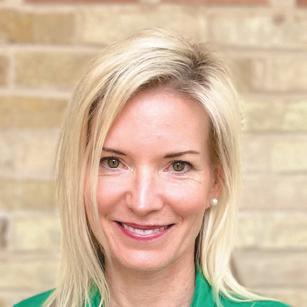
Despite her vast responsibilities, Grace keeps her purpose in mind.
“This school is filled with amazing students,” she said. “At the [administrative] team level, we talk a lot about putting the student experience first. That is why we are here.”
However, the next hole proved to be way more treacherous.
Love is in the air! In the spirit of Valentine’s Day, the Evergreen senior staff took a weekend to plan the perfect date night for all our readers to enjoy.
After much deliberation, we landed on a round of miniature golf at Puttshack and a comforting meal at Ramen Hakata.
Here is how it all went down: Walking into Puttshack, most of us had no idea what to expect. Varun had been before, but for the rest of us, it was uncharted territory. We assumed it would be a standard mini golf experience, similar to TopGolf. We quickly realized how wrong we were. Puttshack was way cooler.
Before we began, each of us was handed a golf ball with tracking abilities. To start each hole, the player had to place their ball on a designated spot, activating the tracking system. A screen above the hole kept score, tracking the number of strokes, point totals and any bonuses or penalties given for completing or failing certain tasks.
We faced a ramp leading to four subsections – each with a different trivia category. All of us landed in either “Food & Drink” or “Entertainment.” The questions were deceptively easy at first, with Lyna being asked if Nemo was a clownfish or a swordfish. However, when Aria mistakenly assumed that chocolate is more widely stolen than cheese, she was bumped to the bottom of the leaderboard for multiple holes to come. Whoops.

As we progressed through the holes, we encountered more interesting challenges. There was a basketballthemed hole and with two varsity basketball players, a basketball manager and two former basketball players on the senior staff, you would think that we would ace this hole. However, only Varun managed to putt into a basket, and it was not even the highly sought after “bonus basket.” Maybe it’s time to retire the basketball shoes.

Rather than traditional mini golf holes, however, each hole at Puttshack was interactive, featuring moving targets, wheels of fortune and unexpected challenges.
The first hole was quite simple, featuring a curved green with two orange “bunkers” that carried a 10-point penalty if you landed in them. Both Varun and Lyna ended up in the trap, leading them to a “sub-par” start.
BLater, we faced a hole with moving airhockey pucks that acted as obstructions. Chloe, Evie and Lyna easily hit holes-in-one, while Aria quite literally broke one of the air hockey pucks. Duality.
Dani had an interesting strategy of just walking up to the ball and smacking it as hard as she could – a strategy that ended up getting her a hole-in-one at the Tetristhemed hole. There was even a Wheel of Fortune-themed hole, however, none of us
were able to get the bonus. As we rounded out the end of the course, we stumbled across a Connect Fourthemed hole. The objective was to putt the golf ball up a skinny ramp through a “bonus” hole in the Connect Four board to get a holein-one. Aria went first and got a hole in one! Her excitement was short- lived, however, as Varun, Chloe and Christan all putted holesin-one as well.
The last hole was a Skee-Ball-themed hole. Aria and Christan’s strong performances bumped them up the leaderboard, though, it was not enough to beat our resident mini golf champion, Chloe. In the end, Chloe won it all, even with her torn ACL. The final score was Chloe (390), Evie (370), Christan (370), Aria (340), Varun (338), Dani (335) and Lyna (310). A successful outing, if we do say so ourselves!
efore we begin our review, we would like to point out that our esteemed managing editor, Varun Mukund, bailed on us for dinner once again. This seems to be becoming a trend, so we would like to publicly shame him in print once again. Shame, Varun!
Now that we got that out of the way, on to the review. Admittedly, our original plan was to go to Cris and John’s, a Vietnamese Mexican fusion restaurant. However, when we got there, the line was out the door, and no tables were open. So, we decided to fulfill our wish from the December issue and go to a ramen restaurant: Ramen Hakata.
When we got there, we immediately ordered a few appetizers: the chashu bun, spicy edamame and pork gyoza. The chashu bun was mediocre. The bun itself was soft and fluffy, but the chashu was tougher than
expected. The spicy edamame had great seasoning, but for some reason, it was drenched in what tasted like General Tso’s sauce. Not ideal. The pork gyoza, though, was a hit. They were pan-fried to perfection with a soft, melt-in-your-mouth filling that had us hooked from the first bite.
After our appetizers, we ordered our main dishes. Unfortunately, the service was a bit chaotic, and our food came out at completely different times. Some of us were already halfway through our meals while others were still waiting. But, the food is the most important part, so, here are our thoughts:
Aria (Udon in Dashi Broth)
The air was chilly and brisk, the perfect weather for a warm bowl of soup. I took full advantage and ordered the udon,

which instantly hit the spot. The noodles were thick and chewy, the kind that make you question every sad cup of instant ramen you’ve ever eaten. Also, the broth had a rich umami flavor, warm enough to revive my soul from the calculus I was doing earlier in the day. Definitely a stepup from Yard House….
Chloe (Tonkotsu Ramen)
At my go-to restaurant, Tonkotsu Ramen is my go-to meal. The creamy broth never gets old, and the first sip warmed my whole body. With a little bit of their spicy paste, it was even better. Having mastered the exact ratio of noodles, soup and pork in my spoon, each bite was more delicious than the last. The perfect boiled egg topped it off.
Christan (Carbonara Ramen)
Arriving with a full stomach from the best church food, I decided to try a new dish on the menu: Carbonara Ramen. Thinking it would be similar to Buldak’s Carbonara Ramen, I waited patiently for it to arrive. Then it came out...looking, well, interesting. Though bland at first glance, it was surprisingly creamy. However, halfway through, I had to give it up. But by the end of the night, I was questioning my life choices.
Dani (Dipping Ramen)
As the self-proclaimed female Anthony Bourdain, this meal fulfilled my expectations. I had been here once before and was hoping it would live up to the previous visit. However, there were some hits and some misses. Although not my main course, the pork gyoza stood out as my favorite. Now for the big hitter, Dipping Ramen. This dish was quite good, albeit the humongous bowl of way too many noodles. The broth was also truly broth to remember.

Evie (Tonkatsu Curry Rice)
As to be expected, it’s pretty hard to mess up a Japanese tonkatsu curry. It came out pretty fast and the katsu was nice and crispy on the outside, with a tender pork cutlet inside. There was, however, an alarmingly large chunk of carrot in the curry which brought the overall score down a bit for me. Overall, the flavors were well balanced, and the rice was steamed to (almost) perfection, making for a filling and satisfying meal.
Lyna (Oyakodon)
While I really enjoyed both the rice and the fried chicken on their own, they didn’t quite complement each other as well as I had hoped. Perhaps it was my mistake to order a rice bowl at a ramen restaurant, but overall, I was satisfied with the meal. I wished there had been a sauce or some filler to tie the bowl together, though the miso soup on the side was a nice touch.
Overall, the Evergreen senior staff rates this “date night” a solid 8.8/10. So, grab your loved ones or best friends, and head over to Puttshack and Ramen Hakata for a night full of good food and fun.
Rory Liu, Sadie Werner
Thirty-two Greenhill students from band, choir and orchestra earned spots to perform with regional and state honor groups in January and early February.
The auditions for the groups and subsequent performances were overseen by the Texas Private School Music Educators Association and the Texas Music Educators Association.
The Texas Private School Music Educators Association encompasses private schools across the state, with competitions broken into four regions. The Texas Music Educators Association brings together both public and private schools, with competitions spread across 33 regions.
Both music organizations have long audition processes for regional and state honors. Earing a seat is a big achievement, according to Upper and Middle School Director of Bands Brian Donnell.
“Our kids, as Greenhill students, have a lot of things on their plate like debate or sports,” said Donnell. “To carve out time to play their instrument at such a high level is remarkable.”
The TPSMEA choral division is split into two sections: an all-women’s treble choir comprised of sopranos and altos and a mixed choir with sopranos, altos, tenors and basses.
This year, eight students made the TPSMEA All-Region Choir with two in the treble choir and six in the mixed choir. To audition, students learned two songs and recorded them with Upper and Middle School Choir Director Emmanuel Espiritu. Espiritu guides the class in learning the assigned pieces. During class, he teaches the notes while encouraging students to practice on their own.
“Making All-Region isn’t just about how well you can sing, it’s also about how good a musician you are and what you do with the notes that make you stand apart,” said Espiritu. “It’s up to them to not only know the music really well but take it to the next level, which I can assist with.”
The All-Region concert was scheduled for Jan. 11 at Trinity Christian Academy. However, because of the snowfall that week, the rehearsal was canceled and the concert was pushed back several hours. As a result, the set list was shortened.
“We did a total of five or six songs while we’d normally do eight,” said junior Ruby Garza.
Nevertheless, Garza says the concert was exciting , attributing her positive experience to the record turnout of Greenhill choir students in TPSMEA this year.
“I’ve done [TPSMEA] in middle school and was in the treble choir my freshman and sophomore year,” said Garza. “It was nice to have this many people this year because last year I was the only one that ended up going.”
On Feb. 15, freshman Amanda Ye became the first Greenhill student in more than 20 years to perform in the TMEA All-State Orchestra in San Antonio. Junior Myra Puri earned placement in TMEA AllState last year but was unable to participate because of illness.
Ye, along with junior Aaron Kuang, junior Yichen Shi, junior Josephina Qiu and senior Varun Mukund qualified for the TPSMEA All-State Orchestra. TPSMEA offers a smaller, more specialized competition as it focuses exclusively on private schools. TMEA has a larger pool of participants that includes both public and private schools, according to Middle and Upper School Orchestra Director Nick Paraskevas.
“TMEA has a long process that starts on May 1 with the announcement of two etudes for each instrument,” said Paraskevas.

“The etudes are lengthy, often five minutes or more, and students spend the summer practicing them.”
For both TPSMEA and TMEA, the audition process requires students at the state level to submit recordings of select parts of the etudes. These are evaluated by judges through two rounds of cuts.
The preparation is a long and demanding process, requiring a lot of focused practice, according to sophomore Benji Lachar.
“It’s not like you can sit at home and just sort of do it at times,” said Lachar, a cellist. “You have to practice consistently, and it requires a lot of attention to detail.”
TMEA’s orchestra includes strings, woodwinds, brass and percussion and TPSMEA’s All-State Orchestra focuses exclusively on strings.
Greenhill students have the option
to audition for one or both organizations, although juggling the rigorous preparation and other commitments can be a challenge.
“Our students are balancing so many commitments, but they still carve out time to practice at a high level, and students who auditioned have worked incredibly hard,” said Paraskevas. “We’re proud of their dedication and hard work throughout this process.”
This year, 11 students qualified for the TPSMEA All-Region Band and seven qualified for the TPSMEA All-State Band. Students can also audition for the region, area and state bands for the Association of Texas Small School Bands. Twelve students qualified for the ATSSB All-Region Band, with two making it to the ATSSB All-State Band.
This year the concert for the TPSMEA All-State Band was Jan. 25 at the Charles W. Eisemann Center in Richardson. The concert for the ATSSB All-State Band was on Feb. 15 at the Henry B. Gonzalez Convention Center in San Antonio.
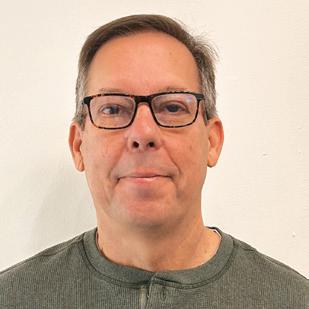
To begin preparation for the auditions, Donnell provides the music to students. The music switches on a five-year rotation for high schoolers, consisting of a slow and a fast piece each year.
“For band, the pieces are more etude exercises, and they are on a set rotation,” said Donnell. “So, if there was someone interested, they could start working on next year’s music because we already have it.”
Although Donnell distributes the music in class, students are expected to prepare outside of class, whether that is with private instructors, by themselves or with Donnell outside of class.
“I got my audition music in the summer and played it once a day until auditions,” said junior Rachel Jiang, who is a flutist.
Hundreds of students may show up to audition with only a few advancing, making the ATSSB All-State Band auditions even more competitive than the prestigious TPSMEA all-state competition, Donnell said.
“We’re proud of all the students who participate in the process, whether or not they make it in the band, because they’ve bettered themselves,” said Donnell.
Following last year’s success of “Into the Hornets’ Nest!” by Jorge Vargas, Texas composer JaRod Hall was commissioned to write an original piece for this year’s Upper School musicians.
The Greenhill Band performed the debut of Hall’s piece, “Resilience,” at the annual Winter Band Concert on Jan. 21.
In 1993 and 2000, Greenhill commissioned a songs for the Greenhill Band. In 2020, Upper and Middle School Director of Bands Brian Donnell began considering reviving the commissions and

got the Cultural Arts Committee involved.
“I started thinking about what we could do in the Band Hall to affect our small portion of the world and add to the catalog of band pieces,” said Donnell.
Last year, the band worked with Vargas on a commission.
“[Vargas] had never been asked to write a piece for a school before,” said Donnell. This made it a “great opportunity for both [him and the band].”
Vargas’ “Into the Hornet’s Nest!” was published last spring, cementing its place in the repertoire of school band music.
This year, the band worked with Hall.
“He wrote the piece early in the year and we didn’t get a chance to connect via Zoom,” said Donnell.
Hall also couldn’t make it to the concert due to the Jan. 9 snowstorm. Despite the lack of direct interaction, Hall’s composition made a large impact on the students, according to Donnell.
“It is a cool and fun piece and will keep the Greenhill history and our reputation alive,” said senior Georgia Thurmond, who plays trumpet.
Hall’s song was originally a Middle School piece, but it was performed solely by the Upper School.
“This song was designed for a smaller band, unlike last year’s, where Middle
ATSSB/TMEA All-State Band
senior Aditi Vikram – clarinet
junior Rachel Jiang – flute
TMEA All-State Orchestra
freshman Amanda Ye – cello
TPSMEA All-State Band
senior Christan Park – flute
junior Rachel Jiang – flute
freshman Owen Gao – oboe
freshman Evan Tsai – clarinet
senior Aditi Vikram – clarinet
sophomore Collin Sun – bassoon
junior Sanay Nesargi – bassoon
ATSSB Region 24/25 HS
All-Region Band
Symphonic Band:
junior Rachel Jiang – flute
senior Christan Park –flute
freshman Deniz Ozturk – clarinet
freshman Evan Tsai – clarinet
sophomore Anya He – clarinet
junior Sanay Nesargi – bassoon
Concert Band:
senior Elizabeth Nassi – clarinet
freshman Eric Xing – clarinet
sophomore Collin Sun – bassoon
senior Ishaan Kandoth – trumpet
sophomore Sonia Brown – French horn
junior Jin Huang – percussion
TPSMEA North Region Band
freshman Eric Xing – clarinet
sophomore Anya He – clarinet
senior Elizabeth Nassi – clarinet
junior Sanay Nesargi – bassoon
junior Jin Huang – percussion
TPSMEA All-State Orchestra
senior Varun Mukund – violin
junior Yichen Shi – violin
junior Aaron Kuang – cello
freshman Amanda Ye – cello
TMEA Region 20 Orchestra
School and Upper School played together,” said sophomore Leo Schnabel, who has been playing trumpet since fifth grade.
Schnabel also contributed to the creative process, helping to pitch ideas for the song.
Donnell’s vision for these commissions goes beyond just creating music.
“I’m very passionate about providing quality opportunities for our students to play music that matters,” said Donnell.
He says he sees these projects as a way to reflect the diversity of the Greenhill student body, while exposing students to unique and meaningful musical experiences.
“I also want to commission works from composers who are in underrepresented communities that reflect the students in our school,” said Donnell.
This program also offers students both a challenge and an opportunity to grow as musicians, according to Donnell.
Donnell says Greenhill and the Cultural Arts Committee’s support for commissioning original works is not only a gift to students, but a contribution to the wider musical community.
With “Resilience” now part of its catalog, the Greenhill Band is already looking forward to future collaborations.
“It’s a unique program that I hope will continue,” said Donnell.
Honors Orchestra: freshman Wayne Wang –violin freshman Ohad Wong – violin freshman Amanda Ye – cello freshman Athena Yu – cello sophomore Benji Lachar – cello senior Asha Blewett – bass
Philharmonic Orchestra: junior Nayan Parikh – violin
TPSMEA Region Choir
Treble Choir: sophomore Natalie Lugo sophomore Kaitlyn Yoo
Mixed Choir: freshman Samy Santosh sophomore Jenna Stenberg
junior Ruby Garza
sophomore Max Backover junior Quaid Oza sophomore Calvin McKee
Aria Kutty
Over the past few months, Hornets have brought their creativity to life through various art forms. From intricate drawings and expressive paintings to creative 3D designs, students have explored different mediums to showcase their talent. Below is a sampling of recent Upper School artistic creations.







Junior Kendall Johnson still remembers the mild horror she felt on hearing the news that the Upper School was ending its daily snack period and swapping out an array of salty and sweet processed snacks for a permanent fruit bar.
“At first I was just staring at that [fruit] crate like, ‘How am I going to survive?’” said Johnson. “Now, honestly it’s been a better shift for me because I’ve been able to go to the Buzz and get something that can sustain me or something small from the fruit bar.”
Similar nutritional changes are occurring across campus.
The Buzz has slowly eliminated many ultra processed foods and drinks such as Takis, Hot Cheetos and sugary soft drinks.
In the High Performance Center, staff members have expanded snack options to offer more nutritious fuel for athletes such as Honey Stinger snacks and Bodyarmor SuperDrink. They also partner with local restaurants to curate healthy pregame options.
“Almost every sport requires a little bit of stamina and even if not, it requires energy in order to perform,” said Johnson. “Something that’s properly fueling you to last however long your game is really helpful.”
SAGE Dining Services, which oversees the Greenhill cafeteria, employs six dietitians to adjust meal plans and has eliminated trans fats from its offerings. The SAGE staff members also use a color-coding system to indicate nutritional value, with darker green representing higher nutrition and lighter green, lower nutrition.
“[SAGE] definitely gives us the option to have a good, healthy meal that’s high in nutrition and protein on a daily basis,” said senior Gabe Shiloh. “It also improves our performance because we’re properly fueled to play after school.”
The ongoing nutritional changes at Greenhill reflect a larger national debate over dietary habits during a time when heavily processed snacks and foods are increasingly prevalent.
For the first time in 30 years, the U.S. Food and Drug Administration in 2024 updated their nutritional standards for what they classified as “healthy” foods. Despite those efforts, agency officials estimate their endorsement labels influence the grocery purchases of less than 1% of Americans.
The changing awareness and attitudes of students suggest that this ongoing struggle to translate aspirational nutritional goals into American’s daily eating habits is meeting with more success on the Greenhill campus. After the initial shock of no longer having processed snacks, some students began satisfying their salty or sweet cravings with purchases at the Buzz. Other students have embraced – or are tolerating – the change to healthier snacks.
“I really like it,” said Shiloh, who is a member of the cross country, soccer and track teams. “I prefer the old snacks more, but I think having a snack is beneficial and I kind of like how you can go at any time of day. For me, [the shift to a fruit bar] wasn’t as bad as it was for most people.”
In addition to nutrition, Greenhill administrators considered multiple factors such as common allergens and cost when they decided to remove processed snacks and instead offer fresh fruit in each division.
“We are a real leader of our friends and students that have dietary restrictions, and we’re very proud of that,” said Director of Operations and Logistics Crystal Dixon. “In order to make sure we are mitigating as much human error as possible, fruit just felt like the best option.”
The Buzz faces a myriad of challenges in choosing its food and beverage offerings. The business must source high quality, nutritional products at a low enough cost that ensures some profit on their sale. In addition to the revenue considerations, the snacks and drinks should be appealing and affordable for the Greenhill community, according to Dixon.
“We look at trend analyses, look at competitive markets to see what are good graband-go options,” said Dixon. “We try to thread the needle of being very balanced, of the things you want, the staples you know but also having the healthier route.”
Similarly to the Buzz striving to offer both healthy and enticing snack options, SAGE Dining Services provides a wide range of prepared breakfast and lunch meals for the entire Greenhill community. SAGE’s food philosophy focuses on building a well-composed plate with appropriate portions of various foods rather than restricting students to a limited group of strictly healthy options.
“SAGE has a food mindset that all foods fit, so all food is good food,” said SAGE Dining Services General Manager Jeffrey Babb. “It’s just some foods you should have in moderation, and some foods you could have more of because they’re essentially better for you.”
School administrators hold the view that both academic and athletic performance are inextricably linked to student nutrition. Many of the nutritional changes aim to cement healthy eating habits that will carry Greenhill students throughout their lives.
in their offices for stressed-out students who often forget to eat.
“I just wish people knew how much eating has to do with your mood. There are sometimes a lot of things that can be solved by someone coming in here and just having a snack,” said Upper School Counselor Amanda Frederick.

“Eating well should affect everything you do,” said Director of Sports Performance Jessen Houston. “When you eat well, you should feel well, you should think well, you should move well and you should breathe well.”
As educators and counselors face rising concerns about student mental health, schools are prioritizing the connection between healthy food choices and emotional well-being. Greenhill counselors keep food
Diet and mental health are closely interconnected, according to studies by National Institutes of Health researchers. Scientists have discovered nutrient-dense foods rich in Omega-3 fatty acids, antioxidants, fiber and vitamins alleviate symptoms of major depressive disorder and anxiety disorders that are prevalent among teenagers.
“On a very basic level, what we eat affects our blood sugar, which can affect our mood, so there’s that piece of it,” said Frederick. “Also, there’s a lot of research that shows our gut health is connected to our brains.”
When stress and perfectionism, common at schools like Greenhill, collide with social media diet trends, students can
develop unhealthy relationships with food, according to Frederick.
“I have noticed that the stuff on TikTok or Instagram can glamorize what could technically be categorized as disordered eating,” said Frederick.
As misinformation surrounding food becomes increasingly common, Greenhill must also consider educating the student body about how to identify false and potentially dangerous information
provides in the cafeteria and fruit bar.
“When I’m in the cafeteria, I look for the protein, which I usually get from the grilled chicken or if they have another healthier meat option,” said Shiloh. “Then I try to get carbs in the form of rice or something, and fiber I get from the fruits and vegetables they have.”
While he prefers the former snack window, he says that he appreciates the convenience of the fruit bar.

and about stigma and shame, and I think we’ve been able to openly talk about the shame,” said Upper School Counselor Kathy Roemer. “But I think also conversations about digital literacy are important and talking about the fact that what we see is not always the truth.”
Shiloh says he feels his goals as an athlete are supported by the fuel that Greenhill
“I really like having bananas and the oranges they have here just between breakfast and lunch,” Shiloh said. “I try to have a banana a day, so if I forget to eat one in the morning, I definitely drop by to come get a banana. It’s [about] wanting to get potassium, and I think it really helps me with running, but also it’s just healthier than the previous things were.”
For the pregame meals of Greenhill athletes, Houston’s High Performance Center now order from local restaurants like Modern Market, Flower Child and Mendocino Farms to curate healthy menu offerings.
Houston says these meals have exposed athletes to new and healthy foods that also improve performance.
“For some of our kids, we also just want to introduce them to new things to consume, like cucumbers, and tomatoes, and spinach and sometimes quinoa,” said Houston.
After consuming these foods, many athletes notice a difference in the way they play.
“When I prioritize my nutritional intake, I see improvements both on and off the tennis courts, and especially in areas of strength and agility,” said junior Aashna Saxena, a member of the girls tennis team.
According to Houston, one of the teams that benefitted from these healthy meals was girls volleyball. Due to their packed game schedule, team members often ordered from these pregame menus multiple
“Our girls volleyball team overachieved this year,” Houston said. “They did more than what was expected of them in their sports performance, and they always consumed the right types of sports nutrition.”
Greenhill is continuing its efforts to enhance nutrition services as part of the broader growth of its athletic program.
“Expanding it more in the new building, we will have a designated sports nutrition space where the kids can eat and [use] fueling stations, so that’s something we’re excited about,” said Houston.
The Athletics Department is also exploring future partnerships with KIND
and Honey Stinger, two brands known for the vitamins and minerals they include in their snacks.
Houston says these snacks and fueling stations are a huge part of their agenda to promote Greenhill athletics.
“If you go into any respectable [NCAA Division I] school, you see [fueling stations] everywhere for the athletes,” Houston said. “We want them for our athletes too. And we also want to make sure that we’re creating spaces for kids to practice wellness, which is having their own space to exercise and eat well without a coach necessarily telling them to.”
Houston’s role has helped enhance nutrition in the Athletics Department. An example of his influence is Foundations of Lifetime Fitness, a semester-long class that establishes the fundamentals of health and athleticism.
Mandatory for students enrolled in Athletic Tutorial or those lacking sports credits, the class covers nutritional science and fitness education, including topics like food processing and energy production, to help students make informed, independent health choices.
“We want students to know [nutrition] so they can practice it and own how they practice it,” Houston said. “With education, anyone can take it and make it their own, and if I’m not here to show stuff, I still want students to be able to understand [nutrition].”
Greenhill’s objective, demonstrated through classes like Foundations of Lifetime Fitness, extends beyond academics. This approach empowers students to make informed health choices, setting them up for long-term success, according to Dixon.
“The long-term goal is to make sure that we are teaching to the best of our ability, making sure everyone understands the need to make healthier choices,” Dixon said. “Students can see the output of [their choices], and that will carry through to adult life.”
SAGE also hopes to make healthier foods available, as well as increasing the variety of meals.
“I see a trend towards healthier options for the people that really enjoy and want to have it,” Babb said. “But I also think the best surprise is the variety of food that the community here is willing to eat.”
Roemer says that moderation helps bridge the gap between obsession and healthy eating, emphasizing that no one should be expected to meet unrealistic health standards.
“It’s okay to pay attention to what you’re eating, but when you become so fixated on it, that’s when I think it’s more of an issue,” Roemer said.
Overall, the nutritional and dietary changes on campus are designed to equip students with the necessary guidance to make informed decisions that will pave the way for their future health and success.
“Because everyone loves food, it’s just our job to make sure you all also love some of the healthy food,” said Houston. “And it is hard, but Greenhill does hard things. That’s what we do.”
Graphic by Chloe Nguyen
On a leafy 75-acre campus that impresses many newcomers, one feature stands out: the eight colorful, squawking peacocks that call Greenhill home.
Greenhill’s peacocks have dazzled community members and visitors since the 1960’s, according to the school’s authorized history. Strolling around campus, these vibrant members of the pheasant family can be found in stairwells, trees, and the ground.
There aren’t many places you can go without running into the colorful birds.
“The birds have become more than just a quirky feature of the school,” said sophomore Valentina Rojas. “They are an integral part of the Greenhill spirit.”
Peacocks first arrived on campus in the mid-1960s after a teacher persuaded a home remodeler who had a fondness for the creatures to gift the school with three of his muster (as a group of peacocks is known), according to the book “From Humble Beginnings,” the history of Greenhill published in 2000 by Associate Head of School for Mission, Community and Culture Tom Perryman ’81 and his brother David Perryman ’83.
Since then, the number of peacocks on campus has grown to eight: five females and three males, according to Greenhill Shipping and Receiving Supervisor Toby

Row, caretaker of the campus celebrities.
Only two have official names: Piper and Shadow. Row says those two already had their names before arriving on campus.
“I know security named the one that’s over by their office,” Row said. “They named him Elvis, and then the one that’s usually outside my door I named Pedro.”
Although commonly known as peacocks, that name technically applies only to the male members of the species known as pavo cristatus, or crested peafowl. The female is a peahen and their young are known peachicks. The birds are native to India and Sri Lanka, but they became popular attractions in zoos and wildlife parks around the world and the Greenhill campus.
Different folks hold different views of the peacocks.
Some students and faculty converse with them, while others limit their interaction to dodging their droppings. Some people openly dislike or actively avoid the peacocks.
When he first got to campus, Upper School English teacher Andy Mercurio fit that category.
“I found them kind of intimidating,” Mercurio said. “There seemed to be a reverence for them that I found a little odd, you know, like ‘nobody messes with the peacocks’ kind of thing.”
Mercurio’s opinion of the peacocks has changed drastically over the 27 years he’s been at Greenhill. Now, he says he communicates with the peacocks daily and

even used one of their feathers to celebrate his 25th year of teaching at Greenhill.
The feather was a gift from one of the longest-serving members of the Greenhill community, Ron Ivery of the Facility Operations and Services staff.
“Mr. Ron brought me this feather,” Mercurio said. “And kids came up with the idea for this whole thing and I got this beautiful tattoo for my Legend year, and I thought to commemorate it with a quill made up of peacock feather.”
Ivery is well known for handing out peacock feathers to students and faculty.
Junior Lily Marshall says that when she was in preschool, she probably had around 20 or 25 feathers.
Marshall vividly remembers being clawed by a peacock in preschool, which she cites as the reason that Ivery gave her so many feathers.
“Mr. Ron had been giving out peacock feathers to everybody, like the long pretty ones, and I really wanted one, so I just went up to one of them and tried to pull one out,” Marshall said. “It, of course, scratched me.”
alerted the school and facilities personnel retrieved the rogue bird.
Tom Perryman has his own peacock tail, recalling the night in 1993 he was sitting in his office at the time, in the Old Farmhouse on the lower campus, when he heard a series of loud bangs.
“I walked out the door and I’m looking around – nothing,” Perryman said. “I go back to my desk, and I’m working, and I hear the banging again, and then I’m just picturing myself in a slasher movie.”

Although she had a rough encounter, Marshall says she probably shouldn’t have done what she did. In the spirit of forgiveand-forget, she appreciates the presence of peacocks on campus these days.
“I like them,” Marshall said. “I feel like it’s good that we have them around.”
Sophomore Isabel Shiloh used to talk to and mimic peacocks when she was younger.
“One time I heard something about like a dog whisperer, and I was like, ‘What if I could talk to the peacocks?’” Shiloh said. “Sometimes they would even respond and call back. Now, I don’t know what I was saying in peacock language. Maybe it was like a mating call or something.”
Sophomore Ayush Shetty, who is new to Greenhill this year, says peacocks made the school feel more inviting.

“I was pretty surprised,” Shetty said. “I did not expect there to be peacocks on campus, but I quite liked it because it made the school day a lot more calming and had a good effect.”
Over the years, there have been several occasions when peacocks have ventured beyond Greenhill’s grounds.
Once, former business manager Ken Piel received a call from Addison’s animal control department saying that six peacocks had escaped, prompting efforts to herd them back onto campus, according to “From Humble Beginnings.”
But the boldest breakout was accomplished by the peacock known as Piper. The multicolored bird somehow made his way about a mile northwest of campus to the Target shopping center at Marsh Lane and Belt Line Road. A Target employee
Eventually, he summoned the nerve to check outside. He saw blood splattered across the window and then spotted the attacker and the victim: It was a lone peacock attacking its own reflection in a window.
“My heart rate finally came back down after that,” Perryman said. “Let’s just say that they’re beautiful, they’re very messy, and they’re not intelligent birds.”
Daily care of the peacocks falls to Row, who feeds the creatures while crisscrossing the campus on his delivery runs. Their diet consists of cat food, bird seed, fruit and nuts. “Usually, they come running after my cart,” said Row. “They see me, and they come running.”
Aside from feeding, Row says the only other major aspect of peacock maintenance is population control during the summer.
Peachicks are sent to local farms to keep the school from being overpopulated and to prevent inbreeding. New peacocks are occasionally introduced to freshen the gene pool, according to Perryman.
“It’s the same family tree that’s been here for 60 years,” Perryman said. “So apparently, you’ve got to be careful with that.”
The peacocks have proven themselves resilient in surviving the turbulent Texas weather, from the 100-degree summer heat to the occasional Arctic blast during the winter months. But the biggest threats, especially to the peachicks, are the occasional coyotes and hawks that scour the campus.
I did not expect there to be peacocks on campus, but I quite liked it because it made the school day a lot more calming and had a good effect.”
In the face of such threats, the peacocks have survived and flourished.
While visitors often react with joy to the occasional peacock sighting, the thrill seems to fade the longer someone is around.
Junior Dylan Millimet, who has been at Greenhill for 13 years, says he doesn’t pay much attention to them anymore.
“I mean, they aren’t too disruptive, so there’s not really a negative and they bring life to campus,” Millimet said.
Perryman says he has noticed a similar trend among other students and from his time as a student and faculty member at the school.
“Once you’ve been here for a little while,” Perryman said, “…you forget how special and unique it is that there are peacocks walking around.”
Cohen. “I think at some point I found this artistic voice.”
Senior Austin Cohen had long been aware of the national prestige and rich tradition of the Miami-based YoungArts program.
Putting his best work up against his artistic peers felt like a good way to end his high school photography career, he said.
The result has been more honors for Cohen and his photography. His portfolio was recently selected as a “winner with distinction” in the competition.
“I think [the competition] is really something that is not replicated in any other high school organization in the world,” said Cohen. “Just the amount of talent that they bring together in one group, that one area. I really wanted to be a part of that.”
After starting his photography career at the St. Mark’s School of Texas in eighth grade, Cohen began seriously pursuing the art form as he entered high school.
“I had previously done band, but my teacher passed away, and I wanted to switch fine arts,” said Cohen. “I’d always been interested in photography, and I had always known that [St. Mark’s] had a very good program.”
In his junior year, Cohen moved to Greenhill and continued his photography journey with Upper and Middle School Photography teacher Frank Lopez.
Lopez says he wanted to put Cohen in Photography 2 when he first came to Greenhill. However, the class had no room, so Cohen was placed in the Photography 1 class.
“Austin was clearly advanced, and I created a special program for him, so he worked at a more advanced level, and I challenged him with individual projects and assignments,” said Lopez.
Cohen says that the teaching methods were very different at St. Mark’s compared to Greenhill.

“St. Mark’s is more conservative; they have very well-established principles that underlie how they teach their program – it’s very good at introducing you to the program and setting that very firm foundation,” said Cohen. “Beyond that, from the conceptual side, I think that is where Greenhill’s photo program helped me. We have access to a dark room and different styles of thinking.”
Both Lopez and Cohen express similar sentiments of Cohen’s development as a photographer and his creative experimentation.
“It’s always wonderful seeing students develop and grow as their own visual artist and the vision that they create,” said Lopez. “I appreciate [Cohen’s] humility. I appreciate his ability to let go of a previous point of view as far as photography goes, and to become very malleable to what I had to bring to the table.”
Cohen adds that after solidifying technical aspects of his craft, he was able to work with alternative methods of photography such as different angles and orientations.
“I did environmental portraits, studio portraits, landscape photography, and I just experimented a lot,” said
In developing his artist statement and portfolio for the YoungArts competition, Cohen took inspiration from two

St. Mark’s friends who were finalists in the program last year. Eventually, he decided to center his art on his brother, Jacob Cohen.
“They gave me ideas of what they did and what other winners did, so I wrote down a list of ideas that I thought that I could just work on,” said Austin Cohen. “I thought that the one that I felt the most comfortable doing, and the one that I felt had the most value was a portfolio of my brother.”
Austin says that when he was trying to come up with ideas, his mom had given him a folder filled with information, journal entries and documentation that she had compiled when his brother was struggling with Crohn’s disease, a chronic disease that leads to inflammation in the gastrointestinal tract. Symptoms include abdominal pain, weight loss and diarrhea.
“I wrote my artist statement around what I saw in that, and about the journey he went through, what he had to experience, how it allowed him to become a stronger person, and just how I think his story reflects what many other people with Crohn’s and other incurable diseases have to go through,” said Austin.
Jacob was diagnosed with Crohn’s going into his ninthgrade year. Unsure of what was happening, he ignored it at first. However, when the symptoms began to get worse, Jacob went to the doctor.
Throughout his journey with Crohn’s, Jacob says his brother has been there to support him.
“I didn’t really go out of my way to tell them how I felt, but whenever he had the chance, he always supported me,” said Jacob.
In his portfolio, Austin used photos of his brother’s


medical reports, medicine cabinets, a weight scale and actual photos of Jacob early in his diagnosis.
“I thought he did a good job of showing the progression from the very beginning,” said Jacob.
Austin Cohen’s selection as a “winner with distinction” in the YoungArts competition earned him a spot to participate in the YoungArts week in Miami and a cash award of up to $10,000. Additionally, he was the only photographer in a field with about 1,500 submissions to earn a perfect score on the judging rubric.
“I could have easily just submitted a portfolio that I made in Norway, or something pretty, but they have 1,000 other submissions that probably look like that,” he said. “So, just try to be different and go the extra mile.”
In Miami, Cohen was surrounded by numerous winning artists across multiple disciplines. They spent a week learning from professionals in intensive classes, showcasing their talents through exhibitions and traveling around Miami to practice their art.
“Just being able to be surrounded by 160 of the top students [in the United States] was an experience that you don’t really get anywhere else,” said Cohen.
He also learned and expanded his photography skills through a portfolio reviewing process where professionals and peers chimed in with their critiques and suggestions.
“I was able to get their insight and then contribute what I thought about their work,” said Cohen. “So being able to work with these people that are very art-oriented was a good experience.”
He also says that he developed lasting connections with top youth artists from around the country.
“Having the opportunity to be a part of [YoungArts] and knowing that you’re going to be part of that group for the rest of your life is a pretty cool thing,” said Cohen. “I’m still in touch with several of the other people that I was there with.”
He views the YoungArts competition as the perfect conclusion to this phase of his photography journey.
“I felt that this is just one way to kind of cap my photography career in high school, and I think by being there, it allowed me to look forward into what I’m going to do in the future,” said Cohen.
Additionally, his portfolio recently won him a Scholastic Arts and Writing Awards Gold Key in the Region-at-Large South. This advances him to compete at the national level and a chance to win up to $12,500 in scholarship money.
As he looks ahead to college, Cohen says he has chosen to double major in business economics and finance at New York University in the Stern School of Business. He says he hopes to take some undergraduate classes in the photography program this fall.
The scholarships he has earned for his photography will be paying for his college education, a further reward for the passion he hopes to continue.
“You can take a camera with you everywhere, and there’s always something to capture,” said Cohen. “It teaches you a different way of thinking about the world.”
Talia Sidikaro, Cate Simpson
With the popularity and strong reviews received by the debut season of the South Korean dystopian thriller “Squid Game,” fans eagerly anticipated the Dec. 26 Netfl ix release of Season 2. Reviews from Upper School students and professional critics have been mixed.
In “Squid Game” Season 1, 456 indebted people are lured into a mysterious competition for a chance to win a large cash prize. The competition requires contestants to play deadly versions of children’s games, such as “Red Light, Green Light” and “Tug of War.” Contestants learn the consequences of each game as losers are killed.
Th roughout the games, the players form alliances to survive and ultimately reach the fi nal round, where only one player can win.
In “Squid Game” Season 2, the winner from the fi rst season, Seong Gi-hun, returns to the deadly games three years later. Gi-hun is determined to dismantle the operation from within by joining the new group of players and exposing the secrets behind the games. He also attempts to team up with a detective to bring down the organizers, even as he faces new games himself.
As the season unfolds, Gi-hun’s goals become harder to achieve as he navigates the dynamics of the games and uncovers secrets about the people behind them.


lethal children’s games that are its breadand-butter. A slow start and frustrating cliffhanger, then, make for an uneven stu mble.”
Huff Post: “The popular Netfl ix series returns with a few familiar faces and some new characters, but leaves audiences hanging at the fi nale.”
Time: “Not that ‘Squid Game’ 2 is a total disappointment. It remains one of the most aesthetically distinctive and compellingly acted shows on TV.”
Freshman Andres Smolensky: “Although ‘Squid Game’ Season 2 was hilarious, it was way too unserious compared to Season 1.
Freshman Ari Beltzman: “In my opinion, I think Season 1 was better because it felt fresh and you didn’t know the outcome, where in Season 2, you kind of knew the outcome in terms of the main character.”
“Squid Game” Season 2 has been reviewed by numerous critics, on and off campus, with a variety of opinions.
Daily Beast: “The new season works when it fi xates on the
Hollywood Reporter: “The second season of ‘Squid Game’ is a thorough letdown…. It’s lacking in the fun and whimsy that kept the fi rst season from wallowing in its backdrop of misery, and entirely lacking in new details or insights on the nature of the Game.
Variety: “‘Squid Game’ Season 2 is bloodier, more expansive and utterly engaging.”
Forbes: “…this is a pretty solid season, albeit perhaps less so than the original, which is no great surprise.”
Sophomore Vikram Sampath: “I really liked ‘Squid Game’ Season 2 because I liked the story. I am excited for Season 3 because I think they ended it all from a good point, even though they didn’t fi nish the games.”
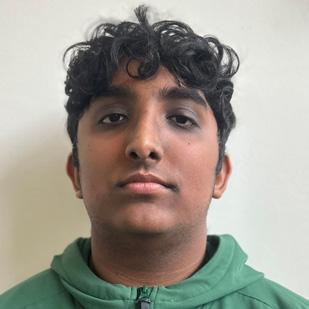
Freshman Srika Kondareddy: “I didn’t really like ‘Squid Game’ Season 2 because it was very predictable, and it just wasn’t like Season 1 at all.”
Daniela Hallack, Khushi Punnam
The Music for a Cause club, founded by senior Aria Kutty in her sophomore year, has become a cornerstone within the Greenhill community, showcasing student talent and fundraising for the Texas Music Project.
Music for a Cause works to promote all types of musical talent within the Greenhill community and share the gift of music with children.
Kutty says she wanted to take her own experience with music and bring that to Greenhill.
“Music education was really important to me growing up,” said Kutty. “I believe that every kid should be able to feel the same joy and happiness that music brought me, which is why I started Music for a Cause.”
Kutty was first exposed to the disparities in music education when she volunteered at a school called All Behaviors Considered in Plano.
“It is a school for children on the autism spectrum,” said Kutty. “They couldn’t have real music lessons, because their entire education [is] focused on learning life skills.”
To give the kids exposure to music education, Kutty would go with her friends to play the guitar and other instruments for them.
The club has had several successful coffeehouse events, concerts and gatherings that have showcased the talents of students.
Senior Brynn Zawadzki says she enjoyed all the coffeehouses as she got to see her peers show off their somewhat hidden talents.
“My favorite part is meeting new people and encouraging students to put themselves out there and express themselves,” said Zawadzki.
Kutty and her leadership team sell pizza and baked treats during each coffeehouse to raise money for the Texas Music Project, a non-profit organization dedicated to raising funds for music education in underprivileged local high schools.
“At the end of my junior year, they reached out to me [and asked], ‘do you want to do a partnership,” said Kutty.

“That is what inspired me to start [Music for a Cause], because I wanted to make sure that all students have access to music education,” said Kutty.
Upper School English teacher and club sponsor Andy Mercurio admires Kutty’s passion for the cause.
The student-led club is “very much an extension of Aria’s love for music and dedication to service,” said Mercurio.
Music for a Cause then became an ambassador for the Texas Music Project.
Being part of this program has been a fulfilling experience for Kutty.
“Music for a Cause has shown me how an idea and a passion can grow into a meaningful organization that makes a difference in my community,” said Kutty.
In late November, Kutty received an email from the Texas Music Project that asked her and two others to perform at the beginning of a Dec. 7 concert by singersongwriter and Grammy winner Lauren Daigle.
Kutty sang with two other seniors: Cassie Rosa and Shreya Chhaya. Both of these seniors are members of the club.
Their efforts yielded a $25,000 donation

to the Texas Music Project to assist in funding high school music programs.
“I sang an original song, and then me, Cassie, and Shreya sang “Birds of a Feather” [by Billie Eilish] together,” Kutty said.
The Daigle concert not only marked a memorable moment for them but also served to raise funds for a cause close to their hearts, said Chhaya.
“If Music for a Cause becomes a Greenhill vehicle for the Texas Music Project and continues to grow this relationship, I would be really happy with that,” Mercurio said.
As the club’s senior leadership team nears graduation, the question arises: will the next wave of students carry forward the same passion and dedication toward the club?
“We have an application process for new leaders at Greenhill so we’re working on getting the new leaders in touch with the Texas Music Project,” said Kutty. “Plus, [Mercurio] really wants us to keep it going.”
Mercurio serves as the club’s faculty advisor and says he is humbled to guide a group that has made a lasting impact on Greenhill and the broader community.
“The leaders who take it next really want the wheel, they want to drive so that they can keep the [club] going down this path,” Mercurio said.
Music for a Cause and the Texas Music Project are now working on “Music Heals,” an initiative aimed at bringing music to children in hospitals.
“It’s been a fantastic and unique addition to the Greenhill life experience, and it means more when this is all really coming from the students,” Mercurio said.
Mercurio says he hopes the new leaders will continue to foster an environment for students both in and out of Greenhill to embrace their passion for music.
“The kids should want to be a part of the community and understand the opportunity for service through performance,” Mercurio said. “The thing that I love about the club is that I’m not the one driving it. I’m just a passenger.”
When senior Noah Piper began attending Greenhill in eighth grade, he decided to try football. With an empty kicker position on the team and a background in soccer, the coach chose him to fill the spot.
As a high school freshman, Piper continued to play soccer and kick on the football team. Then, as a junior, he decided to commit to football. He quit his club soccer team and focused on his kicking, practicing outside of school every week.
Now, as a senior, Piper is the third best kicker in the national class of 2025 and a five-star recruit, according to the website of Chris Sailer Kicking, a private training academy. Because of his ranking, Piper played in the 2025 Navy AllAmerican Bowl and is committed to play at Yale University.
“I couldn’t just continue to dip my toe in both [soccer and football],” said Piper. “I had to go all into one. My family and I recognized that the path that would open up the best opportunity for my future was through football and also that I could play at a higher level in football than I would’ve been able to through soccer.”
Piper spends a lot of time working on his technique and getting in the right mindset for competition. He practices several times a week, kicking either by himself, with the school team with private coach Jaden Oberkrom, a former kicker for Texas Christian University.
Piper first began practicing with Oberkrom after his freshman season. After his sophomore season, he was inspired by football Head Coach KJ Williams to practice more and drop club soccer.
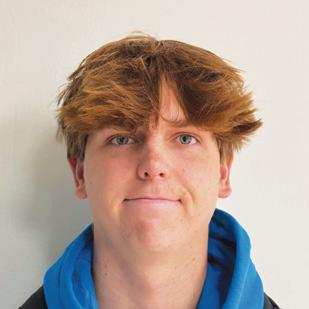
“[Williams] told us during the season that the only thing that would take us from who we are to who we want to be was discipline,” said Piper. “That resonated with me a lot and made me realize that I wasn’t exactly where I wanted to be.”
These practices along with kicking camps helped Piper progress.
“I kicked every day after school mostly because of what Coach KJ had said to us,” said Piper. “This was when I saw the greatest improvement and realized that I really enjoyed doing it. After all this training was when I started to receive attention from NCAA D1 schools for football.”
Piper has played for the varsity team since his freshman year. In his final season last fall, he scored a total of 53 points and maintained an average of around 32 yards per punt. As he has developed as a player, Piper says that he has continued to love playing for the school.


“Friday games are always just so fun [with], you know, the band, the stands, all the Greenhill students and families,” said Piper. “It’s just a feeling that you don’t get from any other sport.”
He says this year has been special since he has been able to set a tone for the rest of the team as a captain.
“As a freshman, you really look up to those guys,” said Piper. “I think now that I am the senior that I used to look up to, it’s super important to be a good role model and try to do things the right way to help those freshmen out, help the younger guys out, so they can ultimately be that guy when they grow up.”
One of the athletes Piper has helped mentor is sophomore Aiden Flanagan, the backup kicker for the team. During practice, he gives him advice on his kicking technique.
“He’s been an awesome leader to the younger kids especially,” said Flanagan. “He just sets a really good example. He’s the one who taught me how to kick and he didn’t have to do that, right? So, it just shows awesome character for taking me and helping me.”
Williams says he has seen Piper’s leadership have a profound effect on the team.
“They see how dedicated he is to his craft, and so from that standpoint, everybody looks up to him,” said Williams. “He is a verbal leader too, so he has the ability to get the kids to lock in when it’s time to go based on the respect that they have for him.”
Piper has committed to play at Yale University, a decision that prioritized both sports and academics.
“I always knew I wanted to go to a highly academic school, and I talked to a bunch of other schools similar to Yale,” said Piper. “The head coach [at Yale] just really treated me and my family really well. Being one of the top schools in the country and being able to maintain my dream of playing Division I football, it just seemed like a no-brainer to me and my family once they offered me [a spot].”
Another factor in his choice was the stability of his position at Yale during a chaotic time in college football because of relaxed NCAA rules governing transfers between schools and the emphasis at many colleges on “name, image and likeness” contracts that allow athletes to earn money from their sport.
don’t get outside of the Ivy League, which was very important to me.”
On Jan. 10, Piper played in the Navy All-American Bowl, a nationally televised high school game in San Antonio with top recruits from around the nation.
Students were split into two teams: one with players from the East and one with players from the West. Each team only had one kicker. In order to make the team, Piper first had to prove that he could achieve certain kicking benchmarks such as average punting yards and accuracy at different yardages.
Afterward, he competed in a “last man standing” competition where each kicker was required to make field goals that got farther and farther from the goal post.
“It’s obviously easy to feel the pressure,” said Piper. “I remember in that moment, I was just kind of trying to treat it like every other kick.”
He ultimately got the spot as the kicker for the East team.
“There were like 24,000 people there, and it was broadcast on NBC,” said Piper. “I think, throughout the whole stream, they averaged over a million viewers the whole time. I never played in a big stadium like that, so it was super cool to be able to play in that type of environment.”
Williams says he is very impressed by Piper’s ability to play at this level and that it reflects his potential to play beyond college.
“These are projected NFL players,” said Williams. “When he goes and he’s competing in that game, Noah Piper is a name starting from that game that people need to consider going to the NFL Draft. It does kind of jump start his path to becoming a pro.”
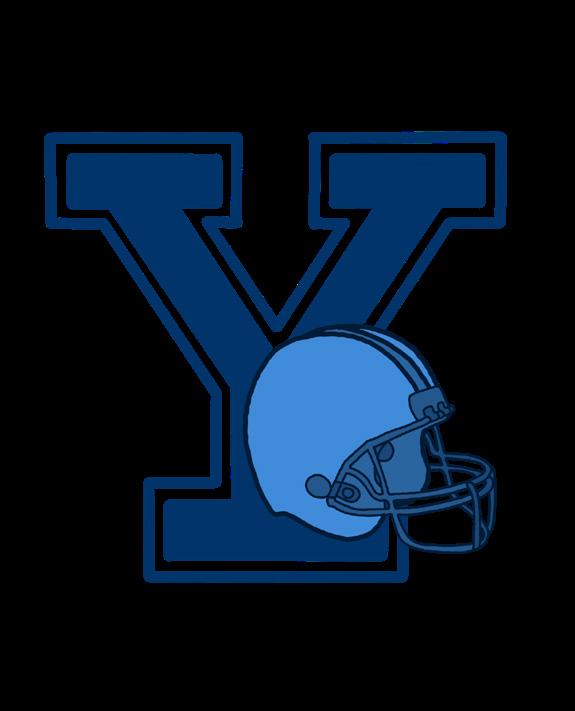
“With the transfer portal, so many of my friends that are also trying to kick in college are getting screwed over,” said Piper. “Colleges can just pay a 22-year-old that has three years of college football experience rather than putting their faith into an 18-year-old coming straight out of high school.”
However, Piper says that happens less frequently in the Ivy League.
“The Ivy League doesn’t take a lot of transfers and the coaches kind of remain the same,” said Piper. “I have seen a bunch of coaches switching around, but the head coach at Yale has been there for 10 years or so. Having the stability and knowing I’ll have the same coaches is something you
As he looks ahead to college, Piper says he is excited about continuing to play the sport he enjoys. “I want to help make an impact on the team and use a lot of my abilities to help the team go really far,” said Piper. “And I think I’ll be able to start as a freshman and do that. I’m super excited about the opportunity and just being able to continue playing football, just because I love it, and being able to continue it at the next level is great.”
After college, Piper says that he would definitely consider playing at the professional level if given the opportunity.
“At the moment, I’m really just focused on helping my [college] team the best way I can,” Piper said.
Piper says that kicking is about having fun regardless of how far he makes it. He says that this mentality keeps him going and improving.
“I think when you enjoy what you do, there’s really no limit to how good you can get,” said Piper. “It can be tough at times, especially mentally, because you make it or you miss it. It can be either you get all the praise or all the hate.”
Chloe Nguyen, Ella Sadka
6:30 A.M.
I wake up and get dressed to go to Crunch Fitness, which is the gym I go to in Plano. I like to get there by 7 a.m. My workout today started with cardio, then legs, and lastly some mobility. Afterward, I lay on the hydrotherapy massage chair.


After the gym, I go back home to shower and eat some eggs. Then I head to work. As soon as I get to Greenhill, I head to my office and start checking emails. Once I respond to those, I see what games we have later in the day to determine what needs to be set up. Since the fields will be used today, I will go put out coolers of water and ice for them.

1:00 P.M.
[Girls lacrosse coach and sports performance specialist] Katie Zarembski and I head to the [Dining Hall] for lunch. Today, the swim coaches joined us. When I get back to the athletic training room, there are kids already there waiting for me to help them with their treatments scheduled for Hornet Block. Treatments vary between rehab, cupping, icing, and everyone’s favorite, Normatec boots. At around 2:50 p.m., the middle schoolers start to show up for taping and treatments.
4:00 P.M.
We get a bigger rush of people getting ready for practice and games. I tape athletes and help them warm up for practices and games. I am always on call in case someone gets hurt at the fields or in the gyms if I am not on site. Tonight, there’s a swim meet, but I’m not staying because [Director of Sports Medicine Nicholas] Salvadar is covering that. I like to walk around to get some sunlight and check on practices because I do work on the bottom floor of the Phillips Family Athletic Center. After practices are over, I clean up for the day, which just involves spraying all the tables and equipment, putting up the chairs and locking up.

6:15 P.M.
After work, I drive to Holy Trinity Greek Orthodox Church. Wednesday night services start at 6 p.m. I miss some of the service but I usually catch the tail end of it.

7:30 P.M.
After the service, my church friends and I meet at Pluckers [Wing Bar] for Wednesday night trivia. We get a table, eat and start prepping for the questions. We’ve done this twice now – the first time we got a $25 gift card for having a funny name. The second time, we got 2nd place and won a $50 gift card. Today, we’re going for 1st place to hopefully receive a $100 gift card.
10:00 P.M.
I go home, shower and brush my teeth. Before I go to sleep, I read my Bible for the day and pray. I like to lay in bed and put a TV show on to fall asleep. 4:15 A.M.
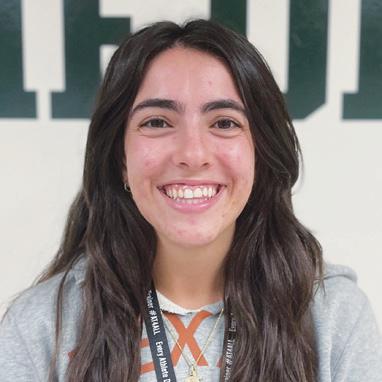
My first alarm goes off. Since I have a busy day ahead, I decide not to hit snooze. I get up and do my morning routine with mobility before completing a workout for about 30-45 minutes.
I arrive at school early for any one-on-one sessions with students or clients. Then, I prepare for the first group of sports performance teams. The morning sessions are always interesting because the kids are just waking up and need a little extra motivation to get through the workout. During [High Performance Center] sessions, we teach students how to do exercises correctly. This helps them reach their athletic and health goals while also avoiding injuries.
I teach my first class of the day, Foundations of Lifetime Fitness, for about 80 minutes. Whether we’re designing workouts or teaching about chronic diseases, the class is always very interactive. Depending on the day, I will either deliver a lecture or have students complete an exercise lab. Today, we are having a fitness and heart rate assessment.

I head over to Workout Challenge, which is a more independent class. Since those students have already taken Foundations, which had more supervision, they simply set a personal goal for themselves. My job is to make sure they do the correct exercises to reach that goal.

During my lunchtime, I work on programming, checking attendance and complete some administrative work. Then, I order sports nutrition meals for our varsity teams, so they have food before their games.
I coach the Middle School afternoon sports performance session, which is very similar to the morning sports performance sessions. The workouts for the seventh and eighth graders introduce them to mastering their body weight and developing athleticism. After quickly cleaning up, I begin setting up for the Upper School afternoon sports performance sessions. I try to sneak lunch in at this time before it gets too hectic in the High Performance Center.
4:15 PM.
We start our first after-school session for the Upper School.
We have our second after-school session at 5:15 p.m. or 5:30 p.m. I coach an in-season team sports performance practice, which is similar to the morning sessions but more abbreviated. Usually, these are either high intensity workouts or mobility-focused; it just depends on what the kids need at that time in their season.
6:15 P.M.
Finally, I make sure all the athletes put their tracking metrics into the TeamBuildr app and go through our closing routine. Sometimes, I stay here later to work individually with a student or client for their own individualized sports performance training.

After I get home, I grab a small bite to eat and I evaluate our programming for the next day’s morning session and make adjustments based on what the team needs and based on any other progressions we want to do. I like to have a quick bite with my family and decompress. I read a few times a week before going to bed.
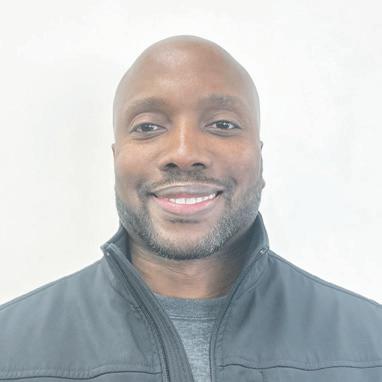
College football is a tradition that millions of Americans care deeply about. Every January, impassioned fans gather around their televisions to watch the College Football Playoff.
And a number of those fans are Greenhill community members.
Emotions were all over the place this year. There were moments of pride, shock, anticipation, relief, frustration, hope and heart-crushing defeat.
Ultimately, on Jan. 20, the Ohio State Buckeyes were crowned the national champions, beating the Notre Dame Fighting Irish 34-23 in the championship game.
This year marked the beginning of a new era of college football with the introduction of the 12-team playoff format.
In the expanded bracket, byes were given in the first round to the top four ranked conference champions: the University of Georgia as the Southeastern Conference champion; the University of Oregon as the Big Ten Conference champion; Arizona State University as the Big 12 Conference champion and Boise State University as the Mountain West Conference champion.
based on just the rankings top down, which is proven by the way that Penn State cooked Boise State,” said junior Dylan Millimet.
Other fans have suggested a format that consists of either eight or 16 teams, in which no team receives a bye.
“I think a bye week in most sports is a good thing, but in college football, it just kind of hurt the teams because they have a routine they’re in,”

said senior Noah Piper, a national-caliber kicker for Greenhill who has committed to play football at Yale University.
Greenhill athletic development specialist Joshua Harris, who played the sport at Wake Forest University and in the NFL for the Pittsburgh Steelers, says he felt similarly, adding that having an enlarged playoff opens the door for weaker competition.

None of those teams won their first game after having a bye, stirring debates among fans.
“I think that [seeding] could instead be
“Maybe it needs to be cut to eight just to make sure that we have the top eight most competitive teams,” said Harris. In addition to the grievances with the bye system, some fans say they miss the stakes that regular season games used to have.
“Teams with three losses had reasonable arguments that they could still get into this thing,” said Upper School math teacher
Jason Zuffranieri, an Arizona State alumnus. “Now rivalry games still mean something at an emotional level, but they don’t really mean anything in a practical level that they used to.”
Despite having some qualms with the new format, fans tend to agree that it is still
better than the former four-team format.
“From a fan perspective, it’s a lot more entertaining to watch a lot of more competitive games,” said Piper.
With more games came more memorable moments.
Senior Brynn Zawadzki, whose parents graduated from Penn State, attended the game against Southern Methodist University.
“It was so cool because Beaver Stadium is huge and I think we had like 107,000 people there,” said Zawadzki.
“SMU’s stadium is like a third of the size and they’re never sold out, so it was crazy to see how that impacted the players.”
Others who did not attend games still say the playoff was one to remember.
Many fans cited the quarterfinal showdown between Arizona State and the University of Texas as their favorite game. The matchup went into double overtime, with the Longhorns defeating the Sun Devils 39-31.
with friends or bonding over tough losses.
Given that Greenhill is in Texas, many students cheered on the Longhorns.
“Texas got to play three games, so I got to watch with my family and all my friends,” said Piper. “[The new playoff format] just builds a community towards Texas football and even every other team in the playoffs too.”
Following teams other than the Longhorns didn’t stop students and faculty from engaging in the fun though.
“It was nice to have a little rivalry [with my friends who are Texas fans] because we were in different paths to the national title, but that created a bonding opportunity because then UT and Penn State both lost in the semifinals,” said Zawadzki. Students were not the only ones partaking in friendly teasing.

“That was one of the greatest games I’ve ever watched,” said Zuffranieri. “I was so proud, even in losing. I don’t normally say that.”
For many students and faculty members, the CFP was an opportunity to create and strengthen connections, whether it was engaging in playful banter, watching games
“[Upper School Science Department Chair] Dr. [Treavor] Kendall and I talk trash to each other a lot,” said Upper School science teacher Emily Myhre, a Georgia alumna. “The fun part around the playoffs is it is a longer period of time where you kind of have that good-natured community, whether you’re on the same team or not.”
Myhre also says that talking about college football helps her build connections with students.
“I definitely talk a lot with my students about football,” said Myhre. “Now that Texas has joined the SEC, I kind of am trying to not be as much of a trash talker about Texas, although it’s hard sometimes. I enjoy engaging with students in some good banter.”

Several Greenhill track and field team members are sharpening their skills by working with Major Impact, a nationally recognized track club.
Major Impact is run by Greenhill’s sprints and hurdles Coach Candida Francois. Coach Candi, as she is known to athletes, aims to train students from all experiences and backgrounds and develop them into the best athletes possible.
Francois and the Major Impact staff have assisted both the Middle and Upper School track and field team in the past. After taking a two-year break from working as a volunteer for the Greenhill team, Francois is stepping back into a formal coaching role.
“We are extremely excited to have her back as an official coach,” track and field Head Coach Stacey Johnson said. “This will only add to the development of her athletes and will build on their consistent work.”
In addition to training athletes, the Major Impact team also fosters character development and good sportsmanship to enable athletes to make a “major impact” on the world, according to sophomore Rian Kinsler.
session is carefully designed by coaches who have competed at both the collegiate and professional levels.
“Coach Candi ran at a high level in college and that is really impressive to us and shows us how to work hard,” said Kinsler.
Major Impact also allows students to participate in an indoor track season during the winter months. These additional months of meets and practice allow athletes to compete at a high level against students beyond their school conference, according to Harrison.

Many students such as Kinsler and junior Nia Harrison have been working with Major Impact for years.
“All the coaches really know what they’re doing,” said Kinsler. “Their overall track knowledge is very broad, and they teach things expanding beyond just track.”
Practices can take place outside on the track, in the weight room or at home. Each
Many private schools that are located in colder climates have an indoor track season. A longer track and field season may give athletes an edge for collegiate recruitment purposes because they get more experience in a sport and have more opportunities to be seen by coaches, according to Student experience with multiseason track and field also appeals to many universities, as the NCAA runs an indoor track season in all three divisions.
“The more any athlete trains and gets out there to compete, the more progress they’ll ultimately make than their peers who aren’t working as hard,” said Johnson.
The renewed role of the Major Impact team is occurring after recent changes within the Greenhill track and field coaching staff. Johnson took the initiative to develop a combined leadership team with returning coaches and Major Impact coaches.
Along with other specialty coaches, the track and field staff affiliated with Major Impact will help develop Greenhill’s sprint


team. This coaching change will allow specialized, more concentrated training that will benefit every area of the team. Though the Major Impact coaches will focus on the sprint team, their encouragement could impact every part of the team, track athletes said.
We are extremely excited to have her back as an official coach. This will only add to the development of her athletes and will build on their consistent work.”
“Having all these different coaches allows for more hands on each athlete,” said Johnson. “This allows each athlete to continue the progress they’ve already
started.”
Harrison says she is looking forward to Francois resuming official coaching duties at Greenhill.
“I’m excited to continue to work with Coach Candi during the school season,” said Harrison. “Her encouraging words help us with both the mental and physical side of the sport.”
With their goal of creating a community of uplifting and talented athletes, Major Impact and Francois have left a long-lasting impression on many students they have coached in the past.
“Even though I don’t run track anymore, I still remember Coach Candi’s support and enthusiasm all the way from when I was in middle school,” said sophomore Alex Han.
Why?
When I first heard that Luka Doncic was traded to the Lakers, I refused to believe it. Even when I saw Shams Charania’s tweet, my first instinct was to assume he got hacked. Maybe someone was pulling an elaborate prank. Maybe I had woken up in an alternate universe where nothing made sense.
But no. It was real. And I was devastated.
Driving past the American Airlines Center on Feb. 2, the night after the trade that shattered the sports world (and my soul), I saw hundreds of fans gathered at the base of the Dirk Nowitzki statue, staring at the words etched into its side: “Loyalty never fades away.”
Clearly, for the Mavericks, loyalty has an expiration date.
Trading Luka Doncic, our franchise cornerstone, mere days after he bought a house in Dallas is cruel and unusual punishment, especially after he just led us to the NBA finals a few months ago. The fact that Doncic and our head coach had no idea it was happening? Even worse. Somewhere in Dallas, a child woke up, saw the news, and
immediately had to be consoled with a Dirk Nowitzki bobblehead, as I had to be.
“He was supposed to have a statue!” one fan shouted. And in that moment, I wanted to run up and join them. We didn’t just lose a superstar; we lost a piece of Mavs culture. Drafting and developing players from the ground up is at the core of who we are as a franchise.
Sure, Anthony Davis is a generational talent. Sure, he’ll be exciting to watch. But come on.
My family has held season tickets for the past three years. I’ve witnessed two deep playoff runs, the highs of Luka’s impossible gamewinners, the lows of frustrating off-seasons. And yet, even if the Mavericks win the next five NBA championships, I’ll hesitate to celebrate.
Because some players aren’t just players. They’re supposed to be legends.
And legends don’t get traded. Luka Doncic, you will forever be a Dallas Maverick.
Signed, A broken-hearted Mavs fan
In a display that would make even the boldest autocrat blush, President Donald Trump unleashed a storm of executive orders – 37 to be exact – in his first week as 47th president of the United States, testing the limits of both his office and democracy.
Signing 26 orders on Inauguration Day, Trump smashed the previous record for most executive orders issued on the first day in office. He signed a number of these in Capital One Arena in Washington, D.C., surrounded by thousands of adoring supporters.
Through these executive orders, he’s proposed changes on a broad variety of topics, many of which will have negative impacts on thousands of American citizens, including the very ones who voted him into office.
None of this is new. The majority of the policies Trump has put into action are based on largely problematic claims that he has made throughout his campaign. Although now, many of his voters, who seem to have forgotten what and who they’ve voted for, are shocked at the changes they are now facing.
Domestically, one of his main priorities has been immigration, which is unsurprising for anyone who paid even the slightest bit of attention to his campaign. Eight executive orders signed on Jan. 20 addressed the entry and removal of migrants in the U.S.
U.S. Immigration and Customs Enforcement have begun arresting hundreds of people each day, many of whom have not actually committed a crime, according to news reports. Contrary to the belief of many American citizens, crossing the border illegally is not a criminal offense. It is a civil one.
However, under Trump’s – let’s be frank – racist plan for identifying criminal immigrants, the number of ICE arrests is increasing daily. In Trump’s own words, “With people pouring in, some of whom – I won’t get into it – but you can look at them, and you can say, ‘Could be trouble.’”
His mindset toward immigration policy is one that will only continue to harm Americans of color and target those who look like “trouble.”
Outside of immigration, he’s made other questionable decisions during his first days in office. In an executive order titled “Ending Radical And Wasteful Government DEI Programs And Preferencing,” Trump
has called for the termination of all diversity, equity and inclusion programs for all federal entities. He also revoked an executive order from 1965 that required federal agencies to engage in affirmative action for women and people of color.
This is a glaring sign of regression. So, ask yourselves, with a president who claims to push for a “great” future, why does it seem like we’re barreling back to the past?
Trump’s handling of foreign policy objectives has also been dubious, at best. His executive orders on foreign policy have weakened America’s bonds with other countries, pushing the nation toward isolationism and jeopardizing our collective safety and economy in the process.
One of Trump’s most damaging foreign policy actions was withdrawing from the Paris Climate Agreement, undermining U.S. leadership in global environmental efforts. By exiting the agreement, Trump sent a message that the U.S. was unwilling to cooperate with other nations in addressing this existential threat.
Most worryingly, Trump withdrew the U.S. from the World Health Organization again, after originally withdrawing from WHO during the COVID-19 pandemic. This decision directly endangers both American and global public health efforts. If allowed to stand, this would make the U.S. one of only two U.N.-recognized countries that is not a member.
“The bottom line is that withdrawing from the WHO makes Americans and the world less safe,” said Tom Friedman, former director of the U.S. Centers for Disease Control and Prevention, in an interview with Time magazine.
Additionally, Trump’s 90-day pause on foreign aid creates instability for developing nations that rely on U.S. assistance for humanitarian and economic support. Foreign aid is not a wasteful “handout,” as Trump depicts it, but rather a strategic tool that fosters goodwill and strengthens alliances. By halting aid, Trump risks creating a power vacuum that China, Russia and other U.S. adversaries can and will fill. The bottom line: if Trump truly wants to mitigate Chinese hegemony, creating opportunities for them to expand their power is not the way to do so.
Overall, whether or not you’re concerned about domestic issues or international relations, Trump’s first week in office has set a dangerous precedent. Strap in for the next four years, because who knows what the president has in store for the American people.


Within the first three weeks of his presidency, President Trump has upended the country with a slew of executive orders aimed at getting to work on his campaign promises of cracking down on immigration and illegal drugs, cutting governmental fat and other issues.
These changes, especially in regard to the efficiency of the federal government, are necessary for decreasing the budget deficit and stabilizing government spending. Trump’s generous offer to give federal employees $25,000 if they resign seems to be the proverbial kick in the pants that our current feckless bureaucracy needs. This decision, impacting nearly 2 million government workers, signals a dramatic transformation of the federal bureaucracy.
Under the Office of Personnel Management’s directive, employees who choose to resign will receive pay and benefits until September, according to the New York Times. It has been estimated that 5-10% of the 2 million people given the option to step down will take the offer.
This is a limited time deal, but the deadline has been extended and it will likely be caught up in courts. The Trump administration is aiming to frame this unprecedented move as an opportunity to create a more efficient government. Critics argue it’s a deliberate purge of employees who may oppose Trump’s policies.
This move will mainly impact older bureaucrats who are eligible for retirement anyway and need that final “push.” In 2022 just about 29% of federal employees were over the age of 55, according to USAFacts.
This approach echoes the tactics of Trump’s close advisor, Elon Musk. After taking over X, formerly Twitter, in 2022, he sent a similar ultimatum to employees.
Now that Musk is spearheading costcutting efforts under the new Department of Government Efficiency, he has positioned himself to make a similar ultimatum to federal employees. The financial incentive offered to government employees serves as a short-term cost but is estimated to yield long-term savings. Musk contends that the
departure of these employees could save the government billions through less inefficient federal spending.
Another method Trump has employed to rid the federal government of workers is the repeal of former former President Biden’s Executive Order 14003, which had reinstated job protections for federal employees. Trump’s action further reduces job security, making it easier to fire workers. This introduces the potential for greater governmental efficiency and accountability, creating employment standards similar to the private sector.
The administration aims to create a system that allows the most productive individuals to rise through the ranks and earn pay benefits. These executive orders are aimed at creating an experienced, merit-based federal bureaucracy. This could mean quicker postal services, Medicare processing, and other essential services. This opportunity was not present prior to the Trump administration and is a fantastic avenue for the administration to utilize as part of their revamping of the tired, old bureaucracy.
Opponents fear this is a politicized effort to consolidate power, specifically by ousting those who may resist Trump’s directives. They warn that weakening bureaucratic institutions could hinder essential services, creating a “Trumpian centered” workforce and instability within important agencies.
Many though do not realize that conservative beliefs do not carry into work done in every part of the bureaucracy. For example, postal workers, key members of our bureaucracy, don’t have any space in their jobs for political bias. Essential workers such as these cannot be terminated based on political alignment. This is really a matter of government efficiency and cost cutting.
This unprecedented move raises questions about governance. Does streamlining bureaucracy enhance productivity, or does it risk undermining stability of the government? Will a new era of bureaucracy come? Will we see innovation like never before?
The answers to these questions will be revealed over the next four years.
Balancing sports, academics and a social life outside of school is no easy task.
During sports seasons, varsity athletes juggle homework and other extracurricular activities in addition to practices, workouts and games.
The Evergreen spoke to athletes and coaches for their insights regarding the demands of balancing involvement in varsity sports with the rigor of schoolwork. Here’s a lightly edited transcript of what they said:
How do you balance your academic workload with athletic commitments?
“For me, making schedules and lists helps me make sure to do the most important things and helps me stay focused. I’ll think about when assignments are due so I can be planning in advance to work on them when I have free time.” – sophomore Noora Qureshi, member of the girls field hockey and soccer teams
“I use my free planner to plan my schedule in advance. Once I get home, I try not to procrastinate and immediately start doing my work.” –junior Nia Harrison, member of the girls track team

How do you support your athletes in balancing their academic workload with the demands of practice and games?
“I try to be upfront with expectations that the team has for the players. Communication, planning, scheduling and
balancing classwork with practice time are all things we encourage and develop as a program.” – girls and boys golf Coach Will Turbyne
How do you manage stress from both athletics and academics?
“A lot of the times stress happens when I have both athletics and games. If I’m really stressed, I’ll take a bath or go to the trainer for a break.” – sophomore Noora Qureshi
“I talk to my friends who can also relate, which helps me manage stress.” – junior Nia Harrison
How has being a varsity athlete impacted your social life?
“Socially, I definitely don’t get to spend that much time with my friends but since they’re also in sports, this is something we can relate about. There’s different socials in sports as well, like you still have a family and community there.” – sophomore Noora Qureshi
What do you do on days when you have both a big game and a major project due?
“This is where time management comes in and planning things days before such as asking teachers for an extension. [Girls varsity volleyball Coach Tatiane Deibert] sends out a week at a glance which helps plan out my week.” – junior Nia Harrison, who was on the girls volleyball team as a freshman
What are the key values of being a good teammate and how do you try to be one?
“I try to help my teammates in an encouraging way. I think the important thing in all sports is having a good culture and making sure everyone respects each other.” – sophomore Noora Qureshi
What do you believe is the most valuable life skill that student-athletes learn from participating in varsity sports?
“Discipline, accountability, selfmotivation, dealing with adversity and all the things that are going to be super beneficial when you are an adult. There’s nothing in class that will give you what sports will give you.” – softball Head Coach Monica Stephens
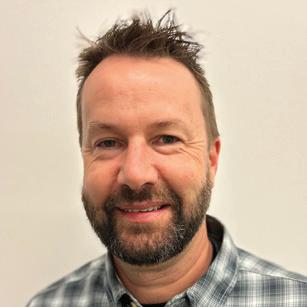
“An important life skill is learning to accept that the process and the outcomes are separate things. But by the same token, you can’t have the outcome you want without following the process.” – girls and boys golf Coach Will Turbyne
What qualities do you believe make a student-athlete successful, both on the team and in school?
“Being able to turn that switch off from school and the stresses from school as soon as they step on a field.” – softball Head Coach Monica Stephens
“I believe dedication to the process is important. I look for resilience and how a player comes back from an undesirable outcome.” – girls and boys golf Coach Will Turbyne
In an era where political polarization dominates the media, politicians set poor examples for how to behave during disagreements and hatred continues to brew, it is more important than ever to engage in civil discourse.
Increasingly, we are seeing people blindly follow movements and prominent figures, falling into dangerous echo chambers. When opinions inevitably clash, minds close and arguments become neverending. The fix to this starts with education.
Civil discourse is not only the foundation of a healthy democracy, but also the cornerstone of social interactions. It’s not just about politics and it’s certainly more than just a polite conversation; it is the ability to listen actively, engage with differing viewpoints thoughtfully and express opposing opinions without
demeaning others.
Far too often, students spend time crafting a rebuttal in their heads instead of actually understanding what others are saying. We as a community need to learn to think about why a peer may have a certain opinion instead of immediately attacking them. Similarly, students fail to separate people from their opinions. We need to stop defining people by their beliefs, but rather by their character and their actions. Being able to respect peers despite diverging viewpoints is a life skill that can’t be taught through PowerPoint; it is only taught through experience.
Granted, in most classes, discussions are open, and teachers refrain from intervening under the agreement that every student remains respectful. Still though, having an open mind and finding common ground instead of dissecting every aspect of disagreement is not emphasized nearly enough.


Time and time again, students fail to see where they may be wrong, talk over one another and gossip about what someone in their class said. If we can’t learn to have respectful, open-minded discussions in a controlled environment, we will be in for a rude awakening in
the real world.
We as a staff understand that the recent grade-wide deliberations were intended to be a starting point for developing crucial skills. With that being said, the question raised did not seem to generate discourse. Also, expecting that a whole grade will stay engaged and take away valuable lessons while a cohort of 10 students deliberates in front of them during Hornet Block – a time where they would otherwise be meeting with teachers, going to clubs or hanging out with friends – is idealistic. The intentions were certainly there, but the execution could have been better.
One key aspect of civil discourse that the deliberations do not address is the idea that consensus is not always something that can be met. Unlike the deliberations, discourse doesn’t always end with a proposal. So, learning when to move on is essential. Making compromise is great, but it is not always possible. When it boils down to it, what is most important is learning to have mutual respect despite differing opinions.
Our proposition is this: in order to promote civil discourse in a productive manner, advisories should spend time discussing difficult topics. They don’t have to be about the state of the economy, immigration or other beasts to tackle, but they should generate conflicting views. A smaller discussion ensures that everyone is participating.
Ultimately, in order for Greenhill to fulfill its vision of seeing “our world made more hopeful because of the Greenhill community,” the school has the tall task of raising a generation of empathetic leaders who are empowered to turn the tide of the close-mindedness plaguing society.
EDITORS-IN-CHIEF
Aria Kutty and Evie Kwei
EXECUTIVE EDITORS
Chloe Nguyen and Christan Park
DEPUTY EXECUTIVE EDITORS
Daniela Hallack and Lyna Kamgang
MANAGING EDITOR
Varun Mukund
ASSISTANT MANAGING
EDITORS
Nora Ahearn
John Hurley
Rory Liu
Kate Ponnambalam
Vedant Subramanian
Sasha Wai
Justin Wu
Noor Zaman
DIRECTOR OF PHOTOGRAPHY Ella Sadka
NEWS EDITOR Sadie Werner
FEATURES EDITOR
Kaitlyn Yoo
ARTS EDITORS
Aanya Bhoria and Vivian White
VIEWS EDITORS
Victoria Gonchar and Lillian Smith
STAFF WRITERS
Jordan Arbuckle
Alexis Chen
Sydney Chien
Cindy Chou
Jin Huang
Ven Larson
Khushi Punnam
Ethan Sadka
Talia Sidikaro
Cate Simpson
ASSISTANT ADVISOR
Amy Bresie
ADVISOR
Gregg Jones
Have a response? Opinion? Original Idea?
Email the Editors-in-Chief: kuttya25@greenhill.org kweie25@greenhill.org
EDITORIAL POLICY
The Evergreen is an independent, student-run newspaper serving the Greenhill School community. It is printed six times during the school year. Print circulation is 900 copies. Past issues are archived at issuu.com/ghevergreen.
Our staff upholds a code of ethics that values honesty, integrity, accuracy and responsibility. Our mission is to help our community interpret campus, local, state and national events through content written and edited by students.
The Evergreen welcomes letters and emails from readers. We reserve the right to edit submissions for accuracy, grammar and length. The Evergreen will not publish material that we judge to be libelous, or obscene, invades privacy or constitutes hate speech. The staff editorial represents the opinion of The Evergreen staff, not necessarily that of Greenhill School.
ADVERTISEMENTS
The Evergreen welcomes advertisements, but we reserve the right to refuse an ad. Business inquiries should be directed to Ella Sadka: sadkae26@greenhill.org
CORRECTIONS & CLARIFICATIONS
To request a correction or clarification, please email kuttya25@greenhill.org or kweie25@greenhill.org
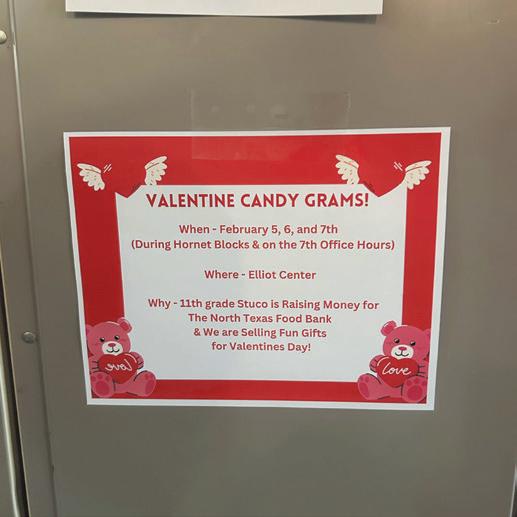

A RAVE to Candy Grams! Courtesy of the junior class officers, these sweet, spirited treats are an annual favorite among students to add some love into their day.
A RANT to the winflu. After Winter Formal, it seems as if everyone got sick at the same time. You cannot go to one class without hearing AACHOOOO!
The fluctuating weather is not helping either. Pick a struggle!

A RANT to exam season. We feel the stress spreading across campus as students get in their last-minute study sessions. Good luck to everyone!

A RAVENT to Bagel Day coming back. We’re so glad to have our weekly treat return, but we’ll miss the $1 price and variety.

A RAVENT to winter sports ending and spring sports beginning. After a hardfought weekend at the Southwest Preparatory Conference championships, we are sad to see the season go, but excited for what the spring season has in store.
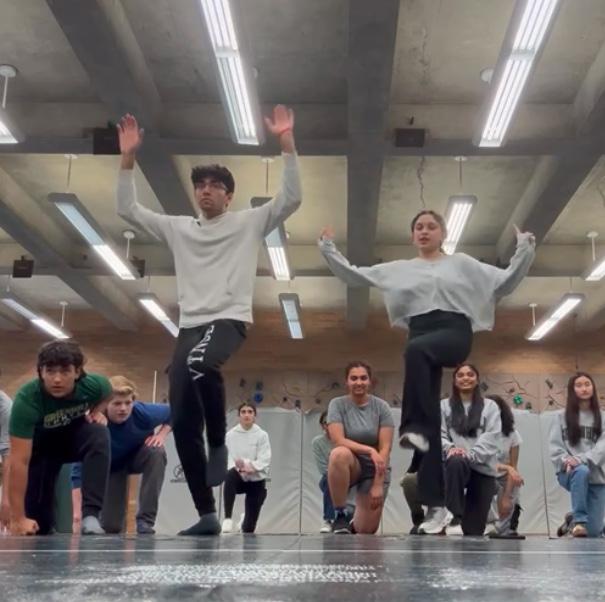
A RAVE to the Bollywood Dance Troupe. With rehearsals underway, dancers of all skill levels have been able to get a taste of South Asian culture. We can’t wait to see them perform in April!

Across 2. ____ the peacock, who escaped campus and traveled to the nearby Target
5. _____ State Buckeyes, champions of the
Best Parking Area: _____
Piece by JaRod Hall, written for the Greenhill Band
____ Greenhill DECA teams qualified for the state conference
Senior Hayden Sampson’s New Year’s resolution: being _____
Winner of the Evergreen Senior Staff’s trip to Puttshack
Discussion style used in the student deliberations started by the Student Council 10. Name of senior Michelle Akins’ website 11. Seniors Shreya Chhaya, Aria Kutty and Cassie Rosa opened for _____ Daigle’s concert in Dallas
Christan Park
Superlatives at Greenhill highlight the everyday favorites that make our school unique. From the best place to open a textbook to the snack that best fuels our day, these titles are a fun way to celebrate what we love most about Greenhill.






